SEASONS
AUTUMN 2023
FARMING NEWS FOR AUSTRALIAN FARMERS

RESILIENT WOOL GROWERS TAKE OUT TOP AWARD AFTER 140 YEARS ON THE LAND
DRENCH RESISTANT PARASITES
HOW TO BEST MANAGE THE PROBLEM NOW!
ON GOING RYEGRASS PROBLEMS?
HOW A GROWER FROM VICTORIA IMPLEMENTED A RANGE OF CONTROL STRATEGIES



Find Us Online Seasons is brought to you by Elders /EldersLimited @EldersLimited @Elders_Limited @EldersRuralServices /EldersLimited elders.com.au eldersrealestate.com.au eldersinsurance.com.au eldersfinance.com.au Contents AUTUMN 2023 Drench Resistant Parasites Are A Concern Right Now 4 High Concentration Drench - Still A Proven Performer For Cattle 7 Value Beyond The Drum 8 Fencing Comes Out On Top With Return On Investment 11 Valor® Eze Adds Convenience When Tackling Problem Winter Weeds 12 Resistant Ryegrass Trial Confirms Early Season Weed Control Change 15 Better Grass Control In Pulse Crop Phase 16 Short Withholding A Winner In Berry Crops 19 Observations On Nufarm’s Terrad’or 20 Multiple Options To Control Ryegrass On Minimay Property 22 Leading The World In Sucking Pest Control 25 Trusted By Australian Growers For 20 Years – Nufarm Tri-Base Blue 26 What Has Kept Tri-Base Blue At The Front Of The Liquid Copper Market For 20 Years? 26 Colex-D, A Vital Tool For Weed Management 29 Startup® Your Crop In 2023 30 Metarex Inov Gives A Quick, Effective Kill 33 Fmc Corporation Raises Funds For Royal Flying Doctor Service For Fifth Consecutive Year 34 Resilient Wool Growers Take Out Top Award After 140 Years On The Land 37 Canola Establishment Now ‘Child’s Play’ At Yerecoin 38 Success For Killara With Investment In Sustainability 39 Money In Mineral Boost For Cattle 41 Animal Performance Accelerates 42 Get Peace Of Mind No Matter Where You Are With The World’s Leading Fence Monitoring System 45 Sow Certainty On Farm With Proven Endophyte 46 New S&W Lucerne Highly Winter Active Genetics 49 Elders Inglewood Branch Managers Going Above And Beyond For Their Local Community 50 Are You Thinking About Planting Retained Hybrid Canola Seed? Here’s What You Should Know 53 A Focus On Procedure And Innovation Ensures Seed Quality 55 Defend Your Crops Against Stress 56 Enhance Your Crop Performance 59 Organibor- A Solution To Boron Application 60 Cyclone’s Tried And True Gate Fittings! 63 2 elders.com.au
The 2022-23 winter crop harvest has certainly been a drawn out process due to wet weather disruptions particularly in the South of the country. While many a header had to be winched out of the mud more than once, the hard work has been worth it, overall production was higher in 2022-23 across several states and prices have held up well particularly for cereals.
Attention will now turn to paddock preparation with extra emphasis on summer weed control and the added workload of smoothing out wheel tracks. Our team have been busy running best practise workshops, catering to the ever evolving world of Ag Tech and field research, leading to improved profitability on-farm. In addition to working with clients we’ve been busy educating our staff on the latest developments in agriculture via key conferences such as evokeAG.
EvokeAG has just concluded for another year and the premier agrifood tech conference didn’t disappoint. Elders is proud to sponsor the event which brings together cutting edge technologies and likeminded individuals all focussed on propelling agriculture into the future. It’s an opportune time for Australian agriculture. The demand for safe, quality, Australian product is at an alltime high, and as a sector we’re well positioned for exponential growth as Australia’s neighbouring populations continue to grow and prosper.




As always, for more information about the products featured in this magazine, we recommend contacting your local Elders branch.
Mark Allison


3
CEO Foreword
DRENCH RESISTANT PARASITES ARE A CONCERN RIGHT NOW
When it comes to cattle most producers are unaware that anthelmintic resistance in cattle is no longer an emerging issue, but is now a real concern. “Today, we are seeing drench resistant parasites impacting the productivity of cattle in different production systems all over Australia”, said Dr Matthew Playford, a veterinary parasitologist with over 30 years of experience in this field, and the owner of Dawbuts, an independent parasitology laboratory.
Research conducted in Australia over the last couple of years has confirmed all major production limiting species of worms (Cooperia, Haemonchus and Ostertagia) have demonstrated resistance to our most heavily relied upon drenches, the macrocylic lactones (the ‘mectins’) plus other classes of drench. These findings are not limited to one geographical region or climatic zone.
Anthelmintic resistance is a genetic trait of resistant worms that allows them to survive drench treatments, which were previously shown to be effective.
DRENCH ADMINISTRATION MATTERS
The way we administer drench treatments also impacts the rate of resistance development. The use of pour-on products results in variablevariable and immeasurable dosing of animals. Some of the pour on product is absorbed across the cattle’s skin and some is absorbed by licking the product off themselves and other cattle. Therefore, the licking behaviours of different cattle can also result in underdosing and therefore should ideally be reserved for scenarios when facilities for cattle handling are poor and human safety is a concern. Injectable or oral drenches are the most effective way to deliver consistent dosing to cattle.
HOW TO MANAGE
To manage anthelmintic resistance on farm, Dr Playford advises that producers should be performing, “routine faecal worm egg count (WEC) as a monitoring tool to assess the need for drenching”. Worm egg counts are correlated with the total number of worms in the animal,
and this in turn is correlated with the product losses which occur. Low worm burdens produce little impact on cattle, whereas high burdens rob cattle of daily weight gain, feed conversion efficiency, milk production and in the worst-case scenario can kill cattle.
EFFICACY OF AT LEAST 95% IS IMPORTANT
Additional to WEC monitoring, farmers should be keeping track of drench efficacy with simple ‘before and after’ drench tests (Drench checks). The WEC obtained can then be used to estimate the percentage of each type of worms killed by a treatment. A benchmark of 95% efficacy is used to indicate whether a drench is performing at an appropriate level of efficacy and to identify resistance.
KEY POINTS
When drenching on your property, all producers should be considering the below key points from our industry experts at Paraboss (for more information go to; Wormboss.com.au)
• Young stock, and cattle under nutritional stress or metabolic stress are more susceptible to worms. Most, if not all cattle will require a drench at weaning.
• High stocking rates, especially in wet and cool conditions will favour larval survival and hence increase the exposure of cattle to worm populations.
• Drench only when necessary, so perform routine WEC to assess need, especially in adult cattle.
• Ask for sensitive tests – those with a sensitivity of 20epg or below.
• Use an appropriate drench – a drench with at least 95% efficacy on your farm.
• Combination products, such as Dectomax V, containing actives from different chemical classes that target the same parasites will have greater efficacy (unless the worms present are 100% susceptible to the drench) as the two actives will have different modes of actions to maximise effect. Combination products also delay the onset of resistance as fewer resistant worms can survive treatment.
• Oral and injectable anthelmintics are considered best practice as they provide higher and less variable blood levels of the chemical than do pour-ons. Oral products however are less likely to achieve high concentrations in the tissues, such as the intestinal wall and skin, compared to injectable products.
• Long-acting products should be used with care as they are likely to increase the levels of resistance (as they have with sheep).
• When treating external parasites like ticks and lice, consider products specific for this purpose if worm control is not also required at the same time.
• Always use a quarantine drench, i.e., combination products, when purchasing cattle to minimise the introduction of resistant worms onto your property.
4 elders.com.au Animal Health
Dr Matt Playford is the Managing Director of Dawbuts. He is a highly skilled and experienced livestock veterinary parasitologist. Dawbuts is focused on providing parasitology diagnostic services; contract research for pharmaceutical companies both in Australia and overseas; training in animal health, production and biosecurity to pharmaceutical and rural store merchandise employees and producers; and on-farm advisory and consultancy to producers.









Premium Performance for Cattle *See product label for registered claims. Zoetis Australia Pty Ltd. ABN 94 156 476 425. Level 6, 5 Rider Boulevard Rhodes, NSW 2138. © 2022 Zoetis Inc. All rights reserved. 02/22 ZL1538 AUSTRALIA’S FIRST DUAL ACTIVE INJECTABLE DRENCH FOR CATTLE effectively KILLS: ROUND WORMS * effectively CONTROLS: Cattle ticks * for 30 days effectively CONTROLS: sucking lice* for up to 56 days


1. Refer to registered label (APVMA No. 60116). Weight gain is not a Cydectin Long Acting claim.
HIGH CONCENTRATION DRENCH, STILL A PROVEN PERFORMER FOR CATTLE
Recent research has found that using a high-concentration injectable drench resulted in steers that were 29.5 kg heavier than untreated animals and 9.9 kg heavier than Dectomax-treated animals over 127 days.1
Virbac Australia collaborated with the NSW DPI and Local Lands Service (LLS) to study the response to injectable drenches.
This study included:
> 280 mixed-breed steers sourced from over 60 properties
> Mean starting weight of 275 kg
> Mixed worm infestation with a high level of Barber’s Pole
HIGH-CONCENTRATION DRENCH DRIVES
CATTLE WEIGHT GAIN
The research found that Cydectin Long Acting injection for cattle is still highly effective against the deadly barber’s pole worm.1*
EFFICACY IS IMPORTANT, BUT WEIGHT GAIN IS EVERYTHING
Results proved that cattle drench efficacy is essential, but weight gain is critical. Over 127 Days Cydectin Long Acting group presented:


> An additional 9.9 Kg compared to Dectomax Injection
> An additional 29.5 kg compared to the untreated group
> That’s up to $52.00 extra per head.**
Treating 100 weaners with Cydectin Long Acting injection for cattle profitability can be increased up to $5,200 compared to commonly used injectable drenches such as Dectomax Injection.
CYDECTIN LONG ACTING FOR CATTLETHE HIGH CONCENTRATION INJECTION FOR CATTLE
It delivers 5 X TIMES more drench active to the animal than 1% injectable drenches, including Dectomax Injection, Dectomax® V injection and Cydectin® Injection. High-concentration drench means improved worm control and longer persistence resulting in enhanced cattle productivity (Weight Gain).
Don’t miss your shot. Choose Cydectin Long Acting injection and improve cattle productivity.

REFERENCES: 1.
*Other
**Based
MORE INFORMATION: au.virbac.com/cydectinla 1800 242 100 7 Animal Health
NSW DPI/LLS (2021) Pearces Creek Efficacy and Production Response to injectable drenches - Virbac data on file. - “Weight Gain” is not a Cydectin Long Acting injection for Cattle registered claim
injectable drenches containing liver fluke actives were also tested, and results are available on request.
on $5.25 kg/LW
VALUE BEYOND THE DRUM
When you purchase a quality animal health solution from Elanco, you are getting far more than the contents of the drum.
You are getting the full resources of one of the world’s largest animal health companies.
Established in 1954, Elanco is a global leader in the research, development and commercialisation of products that improve the health and well-being of food and companion animals.
It markets more than 200 brands in 90 countries throughout the world.
Some of its well-known brands used in the sheep and wool industry include CLiK™ Extra, Zolvix™ Plus, Extinosad™ Eliminator, Extinosad™ Pour-On, Piranha™ and Viper™ Pour-On.

Likewise, beef producers would be readily familiar with Acatak™ Duostar, Bayticol™, Bomec™, Co-Ral™, Component™, Compudose™, Cylence™ Ultra, Fasinex™, Patriot™ and Rumensin™.
Many of these products are manufactured locally to world-class standards to ensure quality, uniformity, traceability and optimal performance.
Local regulatory teams work with government and industry organisations to ensure compliance and access to global markets.
Elanco employs more than 100 staff in Australia, including 20 regionally-based territory managers, strategic account managers and technical consultants.
They include Senior Territory Manager, David Rathbone, based in Wagga Wagga, NSW. His region encompasses the Riverina, south-west slopes, southern tablelands and the Monaro.
Raised on a sheep farm at Tullamore in central NSW, David graduated with a
Bachelor of Animal Science degree from Charles Sturt University in 2010.
He joined Elanco in 2017 after spending more than six years in the rural merchandise sector.
Equal parts animal health advisor, adult educator, business manager and company ambassador, his role demands up to 100 nights away from home and 75,000 km of travel every year.
David completes more than 200 on-farm and 200 in-store visits every year, as well as participating in dozens of livestock shows, sales, field days and industry events.
“Put simply, my job is to make sure livestock producers get the most from their investment in quality animal health solutions from Elanco,” he says.
“Sure, you can save a few cents per head by using a cheaper product, but you are missing out on a range of value-added services that can help you to get the best outcome.
“That starts with providing regular training for all reseller staff to make sure producers are getting the best advice when they are in-store.
“There are something like 1200 rural supply stores throughout Australia and probably over 5,000 staff.
“Every one of them relies on R&D companies like Elanco for training.
“We conduct hundreds of in-store training programs every year, from simple ‘lunchand-learn’ refresher courses to formal twoday workshops.
“We then spend a lot of time on-farm discussing strategic animal health programs and best practice guidelines with producers, contractors and farm staff.
“We’ll show them how to apply the product correctly and safely and that their
applicator is properly maintained – and then we do the first race with them to make sure everything is working properly.
“I’d probably install about 50 Power Doser™ maintenance kits each year in my region alone.”
David conducts up to 80 worm egg count, drench efficacy and drench resistance tests each year.
“The amount of drench resistance out there is really quite staggering, and you’d never know if you don’t test,” he says.
“Some drenches, even triples, are delivering way below 98% or even 95% efficacy, which means some producers have limited drench options.
“I really like the diagnostics side of the business. Any territory manager can say, ‘Here’s what you should be using’.
“For me, it’s far more satisfying to be able to say, ‘Here’s the results of a scientific test that objectively shows us what’s going on’.
“Elanco is fortunate to have a lot of great brands, so often the best solution is an Elanco product but there are times when it’s not and we’re happy to recommend accordingly.”
David also works with Elanco’s technical consultants to follow up any time a producer experiences an outcome that was less than expected when using an Elanco product.
“Elanco stands behind the integrity of our products and will always investigate any concerns for the betterment of both parties.
“With Elanco, you get value beyond the price of the drum.”
David’s commitment, initiative, motivation and positive ‘can-do’ attitude has seen him named as the company’s Salesperson of the Year for the past two years.
8 elders.com.au Animal Health
Acatak™, Bayticol™, Bomec™, CLiK™, Co-Ral™, Component™, Compudose™, Cylence™, Extinosad™, Fasinex™, Patriot™, Piranha™, Rumensin™,, Viper™, Zolvix™, Elanco and the diagonal bar logo are trademarks of Elanco or its affiliates. ©2023 Elanco or its affiliates. EAH23018. PM-AU-23-0043
Elanco’s comprehensive portfolio of animal health products includes some of Australia’s most trusted solutions for the control of lice, blowfly, worms and liver fluke. Together with Elanco’s expert customer service and technical support, these products help make sheep and wool production efficient, profitable and sustainable.


CLiK™, CLiKZiN™, Extinosad™, Fasinex™, Zolvix™, Elanco and the diagonal bar logo are trademarks of Elanco or affiliates. ®Registered trademarks. ©2021 Elanco or its affiliates. PM-AU-21-0335. EAH21176.

































CHOOSE A FENCE DESIGN WITH NOW EASIER THAN EVER, GET PLANNING TODAY! Visit www.waratahfencing.com.au to find out more. IN THREE EASY STEPS CHOOSE A COMMON FENCE DESIGN SUBMIT YOUR QUOTE REQUEST 1 2 3 ENTER YOUR CONTACT DETAILS & CHOOSE YOUR WARATAH DISTRIBUTOR LIVESTOCK FENCING EXCLUSION FENCING
FENCING COMES OUT ON TOP WITH RETURN ON INVESTMENT
When you mention the word ‘fencing’, most people immediately think, ‘significant upfront cost & no long-term benefit’. However, when a problem is identified fencing, especially good quality fencing, can be the a smart choice with providing huge benefits. One of those is a return on investment (ROI)!
Stuart said that “you’d come out some mornings and you would see sheep with organs eaten out and it would just make you sick.” Even with trapping and hunting there was still a 3% loss of stock, which added up.
The dogs were also costing them valuable time that could have been used elsewhere, “When someone sees a dog track, I more or less don’t do anything else but chase dogs till I’ve got them” Stuart said.
If wild dogs and feral animals are causing your livestock issues such as disease, increased mortality rates, or increasing your grazing pressure, you aren’t alone.
Stuart and Leslie MacKenzie run 22,000 acres of mixed livestock farming on a property east of St George. Before contacting Waratah for a solution, wild dogs were ravaging their livestock.

Both Stuart and Leslie knew they needed a permanent solution to give them back their time and help prevent further stock losses. They decided to upgrade their farming operations by getting in contact with Waratah for an exclusion fencing solution that works.

The MacKenzie’s opted to install an exclusion fence using 15/150/15 Stocksafe-t® Longlife Blue® with apron, 1 line of 2.00mm high tensile barbed wire Longlife Blue on top and Blue Latch™ posts. This fence design was effective at preventing dogs from

easily climbing the fence and was also an effective height to prevent other feral animals getting into the property. The apron added that extra protection from dogs burrowing under the fence. Stuart and Leslie understood the value of the Blue Latch posts stating, “it means you have 1 person not 10 installing your fence, meaning a reduction in our labour costs.”
When asked why they decided to use Waratah fencing Stuart said, “I did a fair bit of research and one of the reasons I chose Waratah is because it is Australian made and it’s been here a long time… we tried other wire and this one comes good every time.”
Stuart and Leslie both expect marked improvement when it comes to their wild dog problems, “We have friends in the area who have done a similar thing, and they are seeing results!”
Advice from Stuart and Leslie, “It’s something I think you got to do if you want to survive… I know at the end of the day we will see the results.”
See what Waratah can do for you. Contact your local Waratah representative today or visit www.waratahfencing.com.au 11 Fencing
VALOR ® EZE ADDS CONVENIENCE WHEN TACKLING PROBLEM WINTER WEEDS
With the steady increase in herbicide resistance in mixed cropping areas and the need for more flexible weed control strategies, growers and their advisors will have a highly flexible and effective new tool at their disposal with Valor EZE* herbicide this year.
Extensively tested under Australian conditions, Valor EZE herbicide is a brandnew formulation from Sumitomo Chemical Australia, expected to be registered in February 2023 in time for this year’s winter crop planting.

VALOR EZE:
> Is a new highly convenient suspension concentrate (SC) liquid formulation of the original Valor herbicide.
> Has new residual weed control recommendations when planting winter crops.
> Controls or suppresses key problem weeds including weeds resistant to other herbicides, both grass and broadleaf weeds.
> Offers long lasting residual weed control often taking out multiple germinations.
> Has short and flexible re-cropping intervals.
> May be used prior to winter crops, lucerne, summer crops or in fallow maintenance.
With Valor EZE, Sumitomo listened to grower’s requests for a more convenient liquid formulation without the hassle associated with water-soluble bags and foil sachets. The result is a highly convenient new liquid formulation with excellent compatibility and mixing properties, set to be available in a 10 litre drum.
With the release of the new Valor EZE formulation also comes a suite of new crop registrations that now expands its uses into a range of winter crops, including:
> Wheat
> Chickpeas
> Faba beans
> Lentils
> Field peas, and
> Lucerne
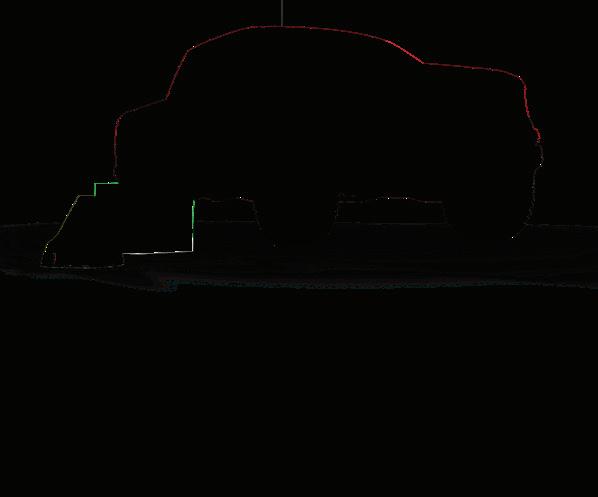
Valor has become well known for its effective and long-lasting pre-emergence control of a broad range of problem weeds in the fallow period and when planting summer crops. Now, with the launch of the new EZE formulation, winter crop growers will also be able to take advantage of the strength and versatility of Valor EZE’s weed control.
Arguably the biggest benefit of Valor EZE’s new winter crop registrations is its Group 14 herbicide mode of action. Valor EZE’s active ingredient has no recorded resistance in Australia to any weed species as yet. Todate, this has been an underutilised group for residual weed control in winter crops.
Another key benefit Valor EZE offers growers is its highly flexible re-cropping intervals and its ability to not restrict growers’ options in a mixed cropping enterprise.
With some of the shortest and most flexible re-cropping intervals available from a residual herbicide, growers can have the confidence they won’t be locked out of particular crop options following a Valor EZE application.
Whilst Valor EZE can provide excellent standalone weed control, Sumitomo also recommend Valor EZE as an excellent tank mix partner for boosting weed control, or simply adding the backup of a Group 14 mode of action herbicide.
Mixtures with products like trifluralin, Boxer Gold®, simazine, terbuthylazine and imazethapyr can be an excellent way of boosting weed control as well as implementing resistance management in winter crops.
12 elders.com.au Crop Protection
PREPARE TO WIN.
PURCHASE $20,000 OF AGCHEM FOR YOUR CHANCE TO WIN A FORD RANGER RAPTOR OR 1 OF 200 AGBOT TANK MONITORING SYSTEMS*




*Terms & Conditions apply. Promotion Period: 1/2/2023 – 31/3/2023. Visit elders.com.au for details. Artist impression only, model may vary.
COMPLETE PACKAGE
TO CONTROL GRASS AND BROADLEAF WEEDS IN WHEAT AND BARLEY IS HERE
Controls a broad spectrum of grass and broadleaf weeds in wheat and barley in both IBS and EPE applications

A unique combination of three active ingredients, including aclonifen, the only group 32 herbicide available in Australia, delivering best-in-class grass and broadleaf weed control Controls weeds across the complete soil surface including in the furrow, when applied EPE

Mateno® is a Registered Trademark of the Bayer Group. © 2023 Bayer Group. Bayer CropScience Pty Ltd ABN 87 000 226 022. Level 1, 8 Redfern Road, Hawthorn East, Vic 3123. Technical enquiries: 1800 804 479 enquiries.australia@bayer.com AVAILABLE IN 10 L & 100 L PACKS NOW REGISTERED EARLY POST-EMERGENCE IN BARLEY SCAN THE QR CODE TO SEE THE LATEST TRIAL RESULTS For more information visit matenocomplete.com.au THE
RESISTANT RYEGRASS TRIAL CONFIRMS EARLY SEASON WEED CONTROL CHANGE
With last season’s arrival of a new cereal pre-emergent and early post-emergent (EPE) herbicide offering growers a potential step-change in their early season weed control, a high-profile Western Australian researcher last year conducted extensive trials featuring multiple herbicide-resistant weeds to confirm the value of the herbicide.
Mateno Complete contains aclonifen (Group 32), a new herbicide mode of action to the Australian industry, in a complementary co-formulation with pyroxasulfone (Group 15), which also is the active ingredient used in Sakura®, and diflufenican (Group 12) herbicides.
ryegrass population, Mateno Complete can control it, as long as the population is not K (Group 15) resistant.’’
The news was good, and hence growers can now be confident of having an effective new tool at their disposal.
Roberto Busi, Weed Scientist with the Australian Herbicide Resistance Initiative (AHRI) at the University of Western Australia, said there were few grass postemergent herbicide options available in wheat and most already had weed resistance levels of up to 50 per cent (pc).

This had resulted in a reliance on preemergent herbicides, which are particularly important with no-till seeding systems, for effective weed control, and where weed resistance has developed over time.
Roberto said resistance to trifluralin, one of the most popular pre-emergent herbicides, was now consistently found at 15 pc, which is one in every six paddocks treated with trifluralin.
Last year, Bayer released the pre-emergent and EPE herbicide, Mateno® Complete, for grass and broadleaf weed control in wheat and barley, which followed the earlier extension of Boxer Gold for EPE control of grass and broadleaf weeds. Roberto has assessed the value of the new herbicide in controlling multiple herbicide-resistant annual ryegrass populations.
Roberto said he wanted to study the longterm efficacy of the herbicide in worstcase scenarios. He valuated it against three annual ryegrass populations with some resistance to prosulfocarb and pyroxasulfone. These included one from Western Australia and two from Victoria, and three populations with some resistance to trifluralin, all of which were from South Australia, and included one that also featured resistance to prosulfocarb and pyroxasulfone.

The extensive plot trial included three replicates and compared a range of standard pre-emergent or incorporated by sowing (IBS) herbicides; Mateno Complete applied pre-emergent, post-emergent following the IBS treatments, postemergent stand-alone, and also in a tank mix with Buctril® broadleaf herbicideThe application of a mixture of Sakura Flow and Brodal® Options post-emergent was also investigated
The trial assessed weed control rate and biomass suppression through to the reduction of weed seedset, which Roberto said was important to evaluate longevity of control.
He said the trial showed the EPE application of Mateno Complete was very convincing, giving growers confidence it would control annual ryegrass post-emergent across the full soil profile, including in the furrow.
“It was impressive to observe the efficacy of Mateno Complete as a true postemergent herbicide capable of fully controlling ryegrass in pots,’’ Roberto said.
“Mateno Complete controls it no worries. If you have a herbicide-resistant annual
He said the trial outcome in the worst-case scenarios was clear that in those tough situations, it was best to use Mateno Complete following an IBS application of an effective pre-emergent grass herbicide with an alternate mode of action.
“Even with the better performing IBS treatments, the weed control runs out; with the EPE application of Mateno Complete giving an improved period of control.’’
The trial generally showed a 10 to 15 pc improvement in control and more than 20 pc in some cases following the IBS application of an effective pre-emergent herbicide.
Roberto said the post-emergent application of Sakura and Brodal Options, undertaken to understand the benefit of the aclonifen component that features in Mateno Complete, was the worst recorded in the trial.
This article
was
written by Elders supplier Bayer Crop Science. Please note: this article contains information of a general nature, and does not take into account your personal objectives, situation or needs. Before acting on any information, you should consider the appropriateness of the information provided, and seek advice on whether it is fit for your circumstances.
(Top) the AHRI trial is trifluralin-resistant annual ryegrass following the pre-emergent application of trifluralin herbicide.
15 Crop Protection
(Bottom) shows the improved control of the annual ryegrass following the early post-emergent application of Mateno Complete herbicide.
BETTER GRASS CONTROL IN PULSE CROP PHASE

Grain growers are taking the opportunity to better control grass weeds and manage herbicide resistance in the pulse phase of their cropping programs following the launch of a new herbicide last season.

Introduced by ADAMA Australia, Ultro® 900 WG is a pre-emergent herbicide with a new mode of action (Group 23/Group E) and has been very well received. It controls annual ryegrass as well as barley grass and brome grass in pulse crops, the latter of which have become more difficult to control in various areas due to the limited preemergent herbicide options available against these grass weeds.

Ultro is registered for use with faba beans, lentils, field peas, chickpeas, lupins, vetch and broad beans, and can also be used in winter fallow.
ADAMA Australia Portfolio Manager Herbicides, Rob Walker, said weed control in pulses had historically been a challenge due to the poor crop competition and relatively few
registered herbicide options available to growers and advisers.
“As a Group 23 mode of action preemergent herbicide, Ultro delivers an alternative herbicide tool for annual grass weed control, helping reduce the pressure on commonly used options in grain legumes, such as trifluralin and propyzamide,” Rob said.
Ashley Pilkington, Market Development Manager with ADAMA Australia in SA, said Ultro was used extensively last year in a wide range of soil moisture and rainfall situations, as well as across different soil textures, and its results and versatility were impressive.
“Soil moisture is critical to activating preemergent herbicides and commencing weed control. Ultro requires less rainfall
and soil moisture to activate than some industry standards, which is why we have seen strong results when conditions can be less-than-ideal at planting,’’ Ashley said.
Bevan Addison, Market Development Manager with ADAMA Australia in WA, said annual ryegrass was a primary target in the State, however Ultro also was being utilised to target brome and barley grass, which were becoming more problematic.
“The use of Group 2/Group B herbicides via imidazolinone-tolerant cereal crops or traditional Group 1/Group A type chemistry in the legume phase has put a lot of selection pressure on these weeds. The arrival of this alternative Group 23 chemistry has been very beneficial,’’ Bevan said.
Image 1: Lupins Annual ryegrass – untreated, 36 DAA. Walkaway trial site, WA 2021
16 elders.com.au Crop Protection
Image 2: Lupins Annual ryegrass - Ultro @ 1.7 kg/ha, 36 DAA. Walkaway trial site, WA 2021
Ultro®
In a field of its own.
Ultro herbicide from ADAMA introduces a new class of chemistry (Group 23) for the pre-emergent control of annual grass weeds in winter pulse crops.
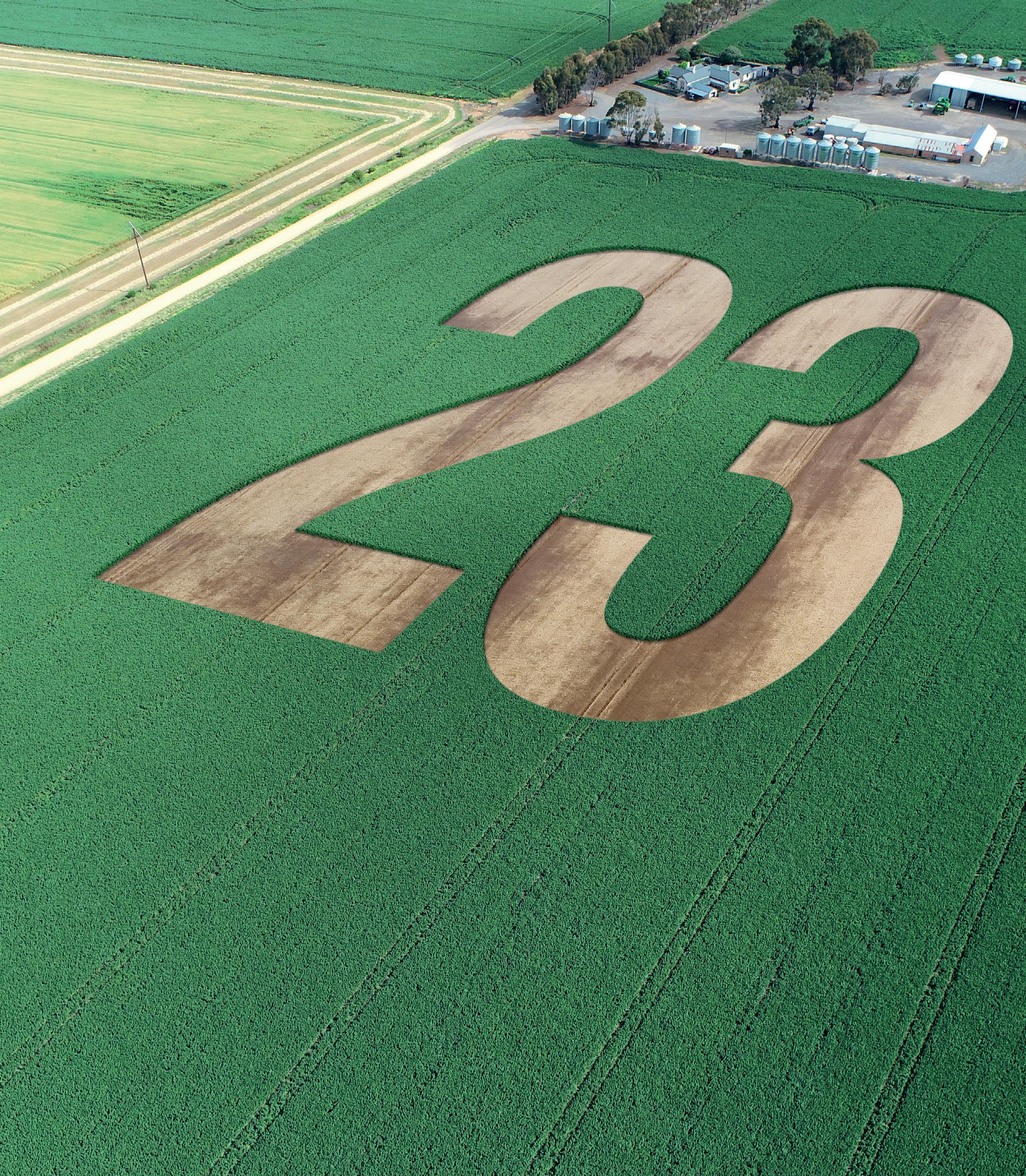
• Controls annual ryegrass, barley grass and brome grass
• Registered in broad beans, chickpeas, faba beans, field peas, lentils, lupins, vetch and winter fallow
• Impor tant tool for herbicide resistance management
• Incorporate by sowing or via rainfall within seven days
Scan here for more information
HERBICIDE
A new dawn. A new standard.
New Miravis ® Prime combines the strengths of proven fl udioxonil (Group 12) and new pydifl umetofen (Group 7) to manage hard-to-control diseases.



These complementary active ingredients attack fungal pathogens in different areas of the plant. They target four different stages of disease development to effectively break the disease life cycle, while aiding resistance management. There’s a new dawn in protectant fungicide technology, powered by MIRAVIS. Miravis Prime. For further information talk to your local Syngenta representative or visit syngenta.com.au/miravis-prime .




IS YOUR CROP PROTECTED?






® Registered trademark of a Syngenta Group Company. © 2021 Syngenta. AD21-090
SCAN HERE
SHORT WITHHOLDING A WINNER IN BERRY CROPS
infection during flowering (blossom blight) can prevent fruit from forming and reduce yields. Botrytis can also cause post-harvest fruit rot later in the season. Therefore, preventing infection from occurring in the first place is critical and flowering is the most vulnerable stage of the crop.
At Paradise Fruits, the raspberry growing season runs for 12 months of the year, using a prima cane and floricane production system in coir bags.
“We’ve already applied MIRAVIS® Prime once this year during flowering when rain was forecast, and conditions were favourable for Botrytis,” said Mr O’Neill.
MIRAVIS® Prime is a major advantage when we have flowering and fruiting going on at the same time and we’re picking at all stages of the year,” said Mr O’Neill.
MIRAVIS® Prime fungicide should be applied preventatively as part of a protectant program with applications beginning when conditions favour disease development and before symptoms develop. With a maximum of two applications per crop, MIRAVIS® Prime fungicide offers excellent protection when used in rotation with fungicides from alternate modes of action.
Like most berry growers, Paradise Fruits battle Botrytis grey mould in their crops every season.
Located at Elimbah on Queensland’s Sunshine Coast, Paradise Fruits have 12 hectares of raspberries under tunnels as well as a nursery for growing plug plants for strawberry growers.
Farm Manager Brett O’Neill said they trialled MIRAVIS® Prime fungicide for Botrytis last year and after seeing good results, have incorporated it into their disease management program this season.
“We trialled the product last year in our strawberry nursery where we can get a lot of Botrytis. Some tunnels were sprayed with MIRAVIS® Prime, some with Switch® and some were unsprayed” said Mr O’Neill.

“We saw good enough results in our trial to start using MIRAVIS® Prime in our raspberry crops this season.”
Although Botrytis is always present, it generally only becomes a problem in cool and wet weather when the fungus is able to infect plant tissue. Botrytis
MIRAVIS® Prime fungicide inhibits Botrytis infection at four stages of development – spore germination, formation of germ tubes, appressorium development and mycelium growth. Fungi cannot grow on the surface or penetrate the plant. This effectively breaks the disease cycle, while managing the onset of resistance.
MIRAVIS® Prime fungicide contains two actives, incorporating the proven performance of fludioxonil with the powerful active pydiflumetofen.

Pydiflumetofen is a new active ingredient developed by Syngenta that belongs to the carboxamide chemical group (Group 7)It diffuses rapidly into the waxy layer of plants, where it accumulates, then moves slowly into the leaf tissue via translaminar movement. The other active ingredient is fludioxonil (Group 12), a contact fungicide that adheres to the outer cuticle of the plant to form a protective barrier.
MIRAVIS® Prime fungicide can be applied at any stage of berry production, from flowering through to just prior to harvest.
“The single day with holding period of
“With its short withholding period, we will choose MIRAVIS® Prime rather than our traditional fungicides,” said Mr O’Neill.
MIRAVIS® Prime fungicide is registered for Botrytis in all berries, including raspberries, blackberries, blueberries, dewberries and currants in both field and protected cropping. It is rainfast within an hour and the suspension concentrate formulation offers good compatibility with other crop protection products.

Mr O’Neill explained that “it’s good to have something up your sleeve for later in the season. We can save MIRAVIS® Prime for high humidity warmer periods during harvest, especially towards Christmas.”
When applied in strawberries for Botrytis, MIRAVIS® Prime fungicide also has activity on powdery mildew.
“I know of strawberry growers in the area who are using MIRAVIS® Prime and raspberry growers as well,” said Mr O’Neill.
“MIRAVIS® Prime is definitely going to be part of our disease management program in the future.”
This article
Please note: this article contains information of a general nature, and does not take into account your personal objectives, situation or needs. Before acting on any information, you should consider the appropriateness of the information provided, and seek advice on whether it is fit for your circumstances. 19 Crop Protection
was written by Elders supplier Syngenta.
OBSERVATIONS ON NUFARM’S TERRAD’OR
brassicas, it’s a very good fit for that. It’s also very good on some of the tougher broad leaf weeds.
Jack Daniel, Senior Agronomist, Elders Mildura

Terrad’or gives us a lot more than what our existing Group 14 chemistry ever gave us in terms of its efficacy on broadleaf weeds. It’s an interesting product given it falls into that Group 14 category, but it’s actually at the higher end of efficacy within that group. I found it was particularly good on brassica species - if you’re looking at another mode of action trying to get into some of the herbicide-resistant
The thing I really like about Terrad’or is the grass additive effect when we mix it with glyphosate products like CRUCIAL or our paraquat blends. That’s very appealing when you look at where we are with glyphosateresistant ryegrass. Over the years, we’ve steadily lost efficacy, so it’s very beneficial to have a product that gives you an additive effect and better efficacy on controlling ryegrass. It’s especially useful when we’re targeting ryegrass with the paraquat-type mixes – I’ve seen what a good fit it is and how effective it is.
I find the short plant-backs are really useful and I’ve used it a lot at sowing. We had a very good opportunity to do a lot of double knocks this year, going in with glyphosate early and then coming in with paraquat.
But if you’ve got broadleaf weeds that have re-emerged, obviously paraquat is going to struggle with that, particularly with some of the tougher species.
Terrad’or offers a really good package in this respect. Not only do we get control of those broadleaf weeds that are emerging just prior to sowing, we’ve got that additive effect with paraquat, so we’re getting very good grass knockdown as well. CRUCIAL is a really important product in this space, but I’m trying to rotate away from glyphosate where it’s appropriate, so being able to use Terrad’or with paraquat in summer is a really good fit as well.
An added bonus is that Terrad’or has been brought to market at a price point that’s appealing to growers. It’s good chemistry at an affordable price and it gives me a lot more flexibility when I’m advising growers.

20 elders.com.au Crop Protection
AUSTRALIA’S NO.1 SPIKE HERBICIDE.
From Improving annual ryegrass control (Including populations with weak levels of glyphosate resistance) in tank mixes with non-selective herbicides through to its proven results on other notoriously hard-to-kill weeds, Nufarm’s Terrad’or outperforms many other Group 14 spike herbicides.
Rigorously field tested in Australian conditions, Nufarm’s Terrad’or, gives growers the edge they need to assist in managing glyphosate resistance. It is a valuable tool when it comes to controlling problem weeds like marshmallow, sow thistle, wild radish and annual ryegrass. Get noticeably faster and better results with Nufarm’s Terrad’or.

For more information, contact your local Nufarm Business Development Manager nufarm.com.au/terrador

MULTIPLE OPTIONS TO CONTROL RYEGRASS ON MINIMAY PROPERTY
The ongoing battle to keep ryegrass at bay has led Clinton Robinson, of Minimay in Western Victoria, to implement a range of control strategies.

“We are just trying to use as many strategies as we possibly can to combat it,” Mr Robinson said. “It’s about not being afraid to throw a few dollars at it, knowing it's one of our worst weeds.”
Ryegrass is the main weed of concern, although brome grass and some others are also appearing in paddocks.
Weed control is obviously important for crop competition, moisture and nutrition management. The ability to minimise ryegrass on farm also has other benefits.
“By keeping weed numbers down we can sow dry every year. We don't have to wait to apply a knockdown, which comes in really handy."
The property is a mixed farm, with sheep and crops which include canola, wheat, clover for seed and hay, and faba beans.
“We have continuous cropping paddocks, which don't ever have livestock on them apart from stubble grazing, and some of our sandier, lighter country has set stocking on it."
“Rotations are generally three years with a legume, whether it's faba beans or clover, followed by canola and then followed by a cereal (mainly wheat)."
Weed control consists of a multi-layered strategy with pre- and post-emergence herbicide options and crop-topping at the end of the season.
“We go pretty hard with our pre-em herbicides. We don't cut too many corners with them. We are just trying to have more
than one strategy to keep ryegrass at bay,” Mr Robinson said.
Over the past two seasons, Overwatch® Herbicide has been used on the property as a pre-emergence option and as a mixing partner with other chemistries.
“I've used a fair bit of paraquat with Overwatch®,” Mr Robinson said. “That worked really well pre-sowing. We’ve also mixed other pre-emergent herbicides with Overwatch® and we find using two modes of action also does a great job."
“We tend to apply a tank-mix of different herbicides to our worst paddocks. We’re trying to mix a few different herbicide mode of action groups to keep resistance at bay. It can be expensive but so is ryegrass when you think about it."
Each year he identifies problem paddocks and goes hard in that particular year to try to get on top of the ryegrass.
Overwatch® Herbicide was first used in wheat in 2021 and in 2022 when the registration had come through it was applied to faba bean paddocks.
“We were really happy with the job it did in the wheat in 2021, especially given the tough start to the cropping season. After just 5 mm of rain Overwatch® could be seen working, when a few of the other chemicals didn't.”
“I think beans are where it will also have a good fit in our program. The crop safety of Overwatch® to the beans is awesome. We were using a bit of Rustler®
beforehand but we didn’t really have any other options in the bean phase, so it’s been really handy now having Overwatch® Herbicide as well.”
“We can get going in a tough start with minimal rain and we sow under some moderate residual stubble at times and Overwatch® seems to work really well in that situation."
While ryegrass is the main problem weed, the other control and suppression options on the Overwatch® Herbicide label are also handy.
“Seeing a bit of suppression of certain things is also good because it doesn't mean you have to get out there straightaway with your post-emergent sprays,” Mr Robinson said. “It buys a bit of time.”
He said the ability of Overwatch® Herbicide to turn the emerging ryegrass a white or pink colour meant he could see it working through the season.
“It gives a good visual, you can see the weeds are getting a gut full and you know it's doing its job. We can still see these effects a long way into the season.”
Overwatch® in canola will also be considered in the future with triazine and Clearfield® tolerant options used on the property.
“We see the odd blow-out in our canola so Overwatch® might be something we will look at in the future," Mr Robinson said.
22 elders.com.au Crop Protection

ALWAYS READ AND FOLLOW LABEL DIRECTIONS. FMC and Overwatch® are registered trademarks of FMC Corporation or an affiliate. © 2023 FMC Corporation All Rights Reserved. 02/2023 UNIQUE MOA FOR BROADACRE GOT OVERWATCH? GOT OPTIONS. When you have Overwatch® in the mix, you’re ready for anything. By delivering broad spectrum control of many important weeds including up to 12 weeks residual activity on annual ryegrass and a nil re-cropping interval to wheat, barley, canola and select pulse crops, only Overwatch® Herbicide gives you the flexibility you need.


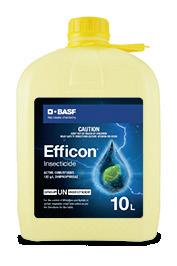
ALWAYS READ AND FOLLOW LABEL DIRECTIONS. © Copyright BASF 2023 ® Registered trademark of BASF. 212935 01.23 Scan to find out more or call 1800 558 399 Power on with Efficon ■ Consistent, long-lasting, reliable control of target pests ■ Controls pests with reduced sensitivity to other insecticides ■ Complements and protects the efficacy of other modes of action ■ Compatibility with beneficial releases strengthens IPM Next generation sucking pest control has arrived Efficon® Insecticide Powered by Axalion® Active Coming soon
LEADING THE WORLD IN SUCKING PEST CONTROL
Australian cotton and vegetable growers are the first in the world with commercial access to a powerful new insecticide developed by BASF. New Efficon® Insecticide is powered by Axallion® active, an innovative mode of action with no cross-resistance to any of the insecticides already in use.
Efficon is effective against a range of piercing and sucking pests. Its worldfirst registrations here in Australia are to control:
•Silverleaf whiteflies and greenhouse whiteflies in cotton, cucurbit and fruiting vegetable crops.
•Green peach aphids and cabbage aphids in brassica and leafy vegetable crops.
•Cotton (or melon) aphids in cotton and cucurbit crops.
Whether you’re growing cotton or vegetables, Efficon will add extra flexibility and reliability to your IPM program. It is especially effective for whiteflies, controlling most life stages and quickly stopping feeding to minimise damage and rapidly control even heavy infestations.
Minimise virus transmission in aphids
That early feeding cessation means virus transmission will also be minimised when Efficon is used on aphids.
Efficon can be applied up to four times across the season, in two pairs of consecutive applications. Its wide application window allows Efficon to be sprayed during flowering and, with its 1-day withholding period, right up until harvest in all the registered vegetable crops.
Efficon is particularly useful at and after crop closure. Its systemic movement through the xylem will protect the whole plant, including ongoing new growth.
The new product’s unique mode of action will control pest populations with reduced sensitivity to older chemistry and, equally importantly, slow the development of
resistance to other products you trust and rely on so they can stay in the rotation. Efficon’s excellent safety profile makes it a strong option to complement beneficial insect releases as well.
“Adding Efficon to the rotation will really strengthen growers’ crop protection whether they’re targeting whitefiles or aphids,” said Serge Usatov, Horticulture Portfolio Manager at BASF Australia.
“We think users will be impressed by how quickly it can bring whitefly infestations under control through its activity on multiple life stages.
In brassicas, cucurbits and leafy vegetables, Efficon can be added to spray programs that already include Versys® to maintain that benchmark level of aphid control.” Serge concluded.
For more information and resources about Efficon, visit your local Elders branch or crop-solutions.basf.com.au.
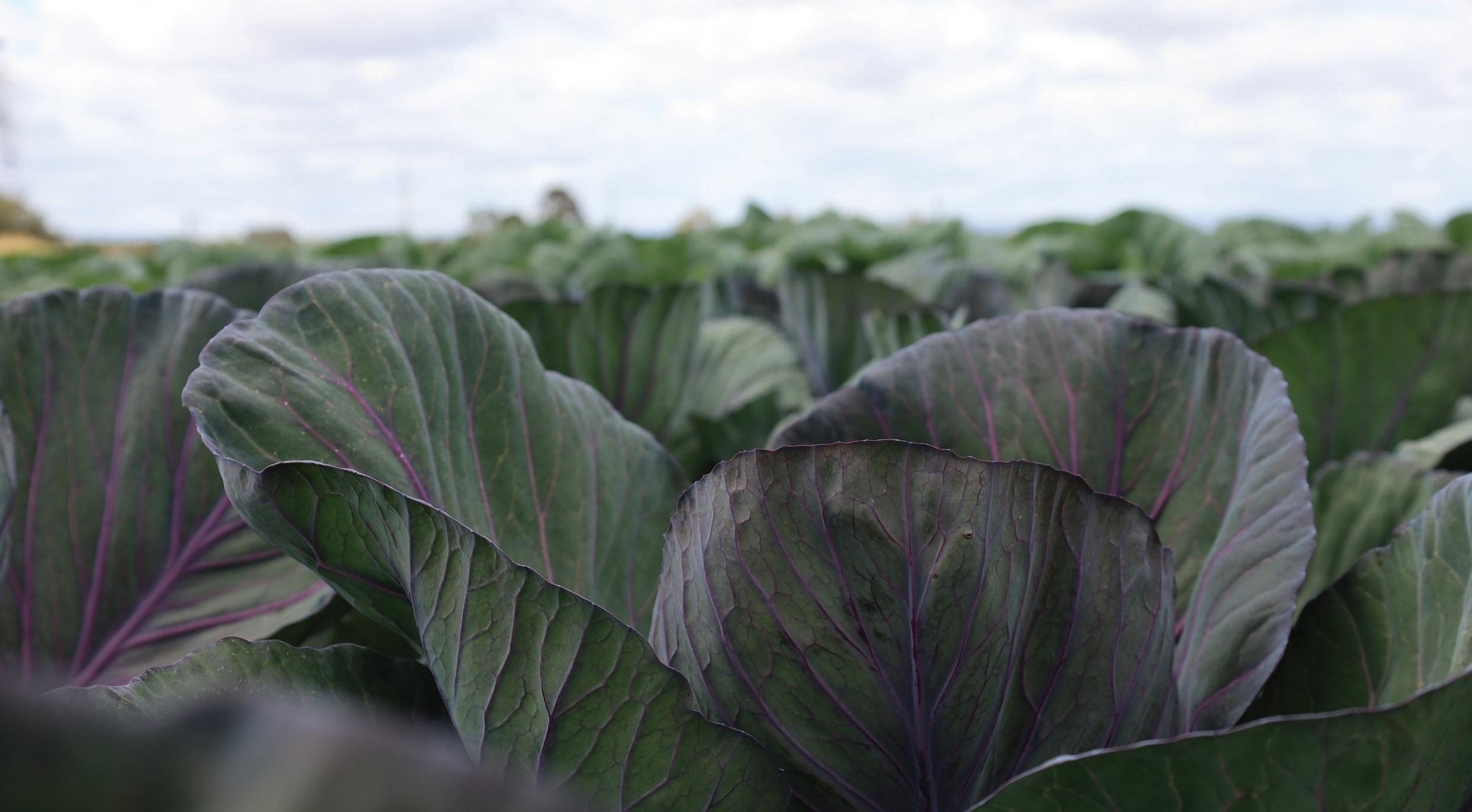
25 Crop Protection
TRUSTED BY AUSTRALIAN GROWERS FOR 20 YEARS – NUFARM TRI-BASE BLUE
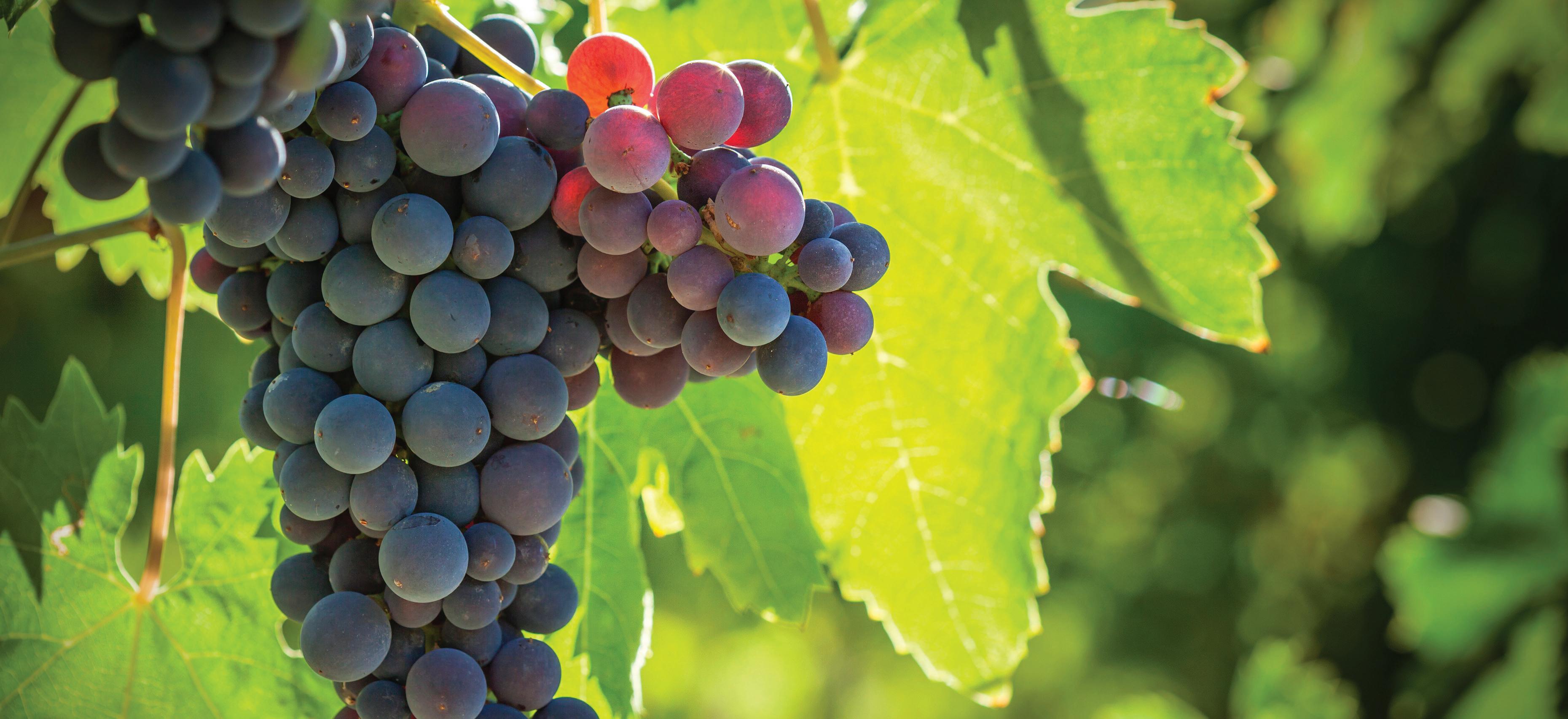
What has kept Tri-Base Blue at the front of the liquid copper market for 20 years?
According to David Rumbold, Nufarm’s Australian Portfolio Solutions Lead, it’s the result of strong investment in a highquality formulation. “There’s always been a fantastic market response to Tri-Base Blue – once growers try it, they almost never go back,” he said.
“According to all the data we have, there have been over 1,200 fungicides registered since Tri-Base Blue came on the market – most of them have lasted maybe ten years. The fact that Tri-Base Blue has reached double the average registration life is a testament to the value that growers placed on it when it was launched and still do today.”
Maintaining that position means recognising the need for constant improvement. It’s why Nufarm has updated the Tri-Base Blue label 10 times since it was first registered, and why Nufarm continues to invest in new data. “Growers are always looking for efficiencies and ways to improve, and we need to keep improving alongside them,” said David. “Whether it’s making the label easier to understand or finding a more cost-effective rate, we’re always finding ways to make sure growers are getting the best out of the product.”
Optimal particle size, optimal release profile
Tri-Base Blue’s superior performance is down to superior chemistry. Strict quality control to deliver a fine copper particle size ensures exceptional coverage
“When the particles in a copper formulation are too large, you’ll inevitably end up with untreated surfaces – and any plant surface that’s untreated remains a potential infection site. In a year with high disease pressure, it’s not a risk worth taking.”
Tri-Base Blue also offers a two-phase release of copper ions, to establish control and then sustain it. It’s a good balance between fast action and sustained release copper.
It’s close to the ideal release profile, according to David. “Growers can have the best of both worlds. Our testing shows 75% of the active copper is released instantly, which gives good control straight after spraying. But the remaining 25% of the copper is released over time, which gives more sustained, long-lasting control to back up that initial release. It minimises the issues with phytotoxicity and still provides excellent longer-term control.”
High compatibility for easy mixing
Formulated with a neutral pH, the Tri-Base Blue’s high compatibility is a big part of its appeal. It sets Tri-Base Blue apart from most copper hydroxides, which raise the pH of the solution in the tank and degrade a lot of insecticides.
“It just makes it so much easier for growers to use,” said David. “It’s compatible with all of the most common mix partners which makes it really easy to integrate into your spray program. Growers don’t have to worry about the inefficiencies of separating chemicals or spraying twice, which they often do with other copper sprays.”
As a liquid formulation, Tri-Base Blue is also much easier to handle than a dry product. “There are no issues with dust, so it’s much more pleasant to use than most dry coppers,” said David. “You can also measure it volumetrically, so you know you’re getting exactly the rate you want.”
And the key to outperforming the competition for 20 years?
Simple, according to David: trust.
“When it comes down to it, Tri-Base Blue has been around for this long because it’s a fantastic product that does a great job. Growers stick with it because they know they can trust it.”
26 elders.com.au Crop Protection
TRUSTED BY AUSSIE GROWERS FOR 20 YEARS.

Get superior protection for your vines with the superior liquid copper formulation, Nufarm’s Tri-Base Blue.

Nufarm’s Tri-Base Blue’s unique liquid formulation makes measuring and pouring easy and dust-free. Whether it be table or wine grapes, Nufarm’s Tri-Base Blue provides reliable and sustained protection against Downy Mildew, and is available in convenient 10 L packs and 640 L shuttles.

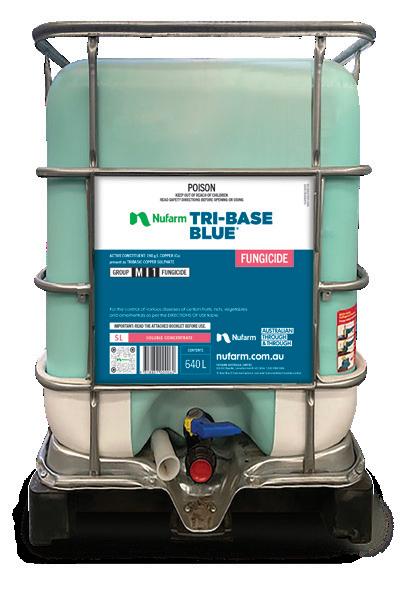
Manager nufarm.com.au/tbb
For more information, contact your local Nufarm Business

© 2021 Nufarm Australia Ltd. All trade marks (®, TM) are owned by Nufarm or used under license, or are owned by third parties and used only to describe compatibility with those related products.
Development
The 2,4-D you can apply with confidence
Colex-D® is a next generation, patented 2,4-D technology that offers the robust weed control of traditional products with the added benefit of field proven Drift Reduction Technology (DRT), near-zero volatility, and ultra-low odour.
Colex-D® allows you to effectively maintain your fallow program and reduce the risk of off target damage to surrounding sensitive crops.
By using Colex-D®, you can be confident that you are doing the right thing by your farm, your neighbour and your community.
To find out more, contact your Territory Sales Manager on 1800 700 096 or visit corteva.com.au

Visit us at corteva.com.au ®,TM Trademarks of Corteva Agriscience and their affiliated companies ©2022 Corteva Agriscience. All rights reserved. October 2022. FR10062.
COLEX-D, A VITAL TOOL FOR WEED MANAGEMENT
Corteva has long recognized the benefits and strengths of 2,4-D as a herbicide.
With its robust broad spectrum activity on some of the most important hard to kill weeds in fallow, it is well justified as a vital tool for weed management. However, for many farmers, the use of current 2,4-D products is becoming increasingly difficult to maintain due to the proximity of 2,4-D sensitive crops and restricted use areas.
Colex-D is a next generation, patented technology that offers all the performance and efficacy of normal 2,4-D products, but has field proven Drift Reduction Technology (DRT), near-zero volatility and ultralow odour built in.
Colex-D will provide a superior offering which will allow farmers to comply with APVMA label requirements and use 2,4-D with more confidence.
What is Colex-D technology?
Colex-D herbicide contains a combination of novel technologies.

1. Colex-D formulation contains proprietary materials that reduce the production of driftable fine droplets. This has been confirmed with wind tunnel tests for specific mix partners and nozzles types which will be detailed on the label once registration is approved.
2. Colex-D contains a new patented form of 2,4-D (choline) that is essentially non-volatile reducing the potential for vapour loss to a fraction of the risk from either 2,4-D amine or 2,4-D ester.
3. Colex-D has been designed with improved characteristics for practical use including ultralow odour and good compatibility.
Guy Sands, Colex-D Product Manager said “Colex-D is an ideal option in Australia because it allows farmers to take advantage of the robust weed control 2,4-D is known for, while significantly reducing off-target movement that has been a problem with older 2,4-D formulations.”
“Colex-D is an exciting development for Australian agriculture and addresses many of the major concerns associated with traditional 2,4-D products.”

29 Crop Protection
STARTUP® YOUR CROP IN 2023
With the potential for another wet start to the planting season next year, the seed that you are planting may be impacted with issues such as water stress (either too much or too little), insects or diseases.
Sylas-ST®, a new super-concentrated biological seed treatment from UPL, can help your seed overcome these stresses by stimulating rapid germination and crop growth, helping to improve root and shoot biomass and helping the seedling manage water stress and nutrient uptake from the soil.
Neil Innes, BioSolutions Manager for UPL Australia said the new seed treatment works well in combination with Zincflo® Plus and Rancona® Dimension – a combination they refer to as STartUP® – to help get your crop off to a flying start.

“Sylas-ST® is produced in the UPL factory at St Malo, in north western France,” said Mr Innes.
“When applied to seeds, this concentrated extract stimulates natural processes to enhance nutrient and water uptake, nutrient use efficiency and tolerance to weather stresses, for better crop performance.”
Sylas-ST® improves the benefits of Ascophyllum nodosum through patented extraction and filtration of this raw material, delivering a super concentrated seed treatment for broadacre growers.
The super concentrate contains up to 26 different plant growth promoting (PGP) hormones. It is the synergy between each of these, rather than the levels of individual PGP hormones, that delivers the benefit.
“The most concentrated forms of these PGPs have been harnessed to create a compatible and low dose form, patenting this process under cool temperature conditions without harsh additives of heat, acids or alkalis,” Mr Innes said.
“The result is a highly concentrated product with very low application rate on seed, that is compatible with other seed treatments and that won’t clog your equipment, making it easy and economical to use.”
The biologically active PGP molecules within Sylas-ST® stimulate the production of enzymes within the plant to increase moisture and nutrient use efficiency. Facilitating water regulation, movement and uptake in the plant enables rapid germination, and the development of an early vigorous root system.
UPL has been trialling Sylas-ST® extensively in Australia. At the time of writing, 2022 trials are awaiting yield results, however early indications are that Sylas-ST® is performing well compared to untreated plots, with an application at 1 litre per tonne showing increases in plant establishment and root biomass.
“Large root systems increase both root mass and depth of access, thereby improving the ability of plants to access water and nutrients, better utilising nitrogen, phosphorous and potassium, which can also help minimise fertiliser over-expenditure,” said Mr Innes.
“Sylas-ST® is highly concentrated leading to very low application rate on seed. It’s compatible with other seed treatments and it won’t clog your equipment, making it easy and economical to use. It is also a NASAA certified input for organic cropping,” he added.
UPL recommend also using Zincflo Plus to help the seedling maximise the uptake of micronutrients such as zinc, an essential micronutrient that enhances disease resistance and improves plant vigour.
With the crop off to a healthy start, it’s important to protect it from yield robbing disease, Mr Innes explained.
“Using Rancona® Dimension seed treatment protects against crown rot, rhizoctonia, pythium, smuts and bunt, in an easy-to-use formulation with minimal dust off during application and handling,” he said.
“The STartUP® seed treatment combination of Sylas-ST®, Zincflo Plus and Rancona® Dimension can assist grain growers optimise seed establishment and growth, as well as protect against yield robbing disease next season.”
This article was written by Elders supplier UPL. Please note: this article contains information of a general nature, and does not take into account your personal objectives, situation or needs. Before acting on any information, you should consider the appropriateness of the information provided, and seek advice on whether it is fit for your circumstances.
30 elders.com.au Crop Protection
YOUR CROP
SYLAS-ST® 1
OPTIMISE SEED ESTABLISHMENT

Stimulate rapid germination & crop growth
ZINCFLO® PLUS 2



HEALTHY SEEDLING GROWTH
Improve plant vigour & disease resistance
Supplement zinc deficiency
RANCONA® DIMENSION
PROTECT AGAINST YIELD ROBBING DISEASES
Protect against crown rot, rhizoctonia, pythium, smuts & bunt
3
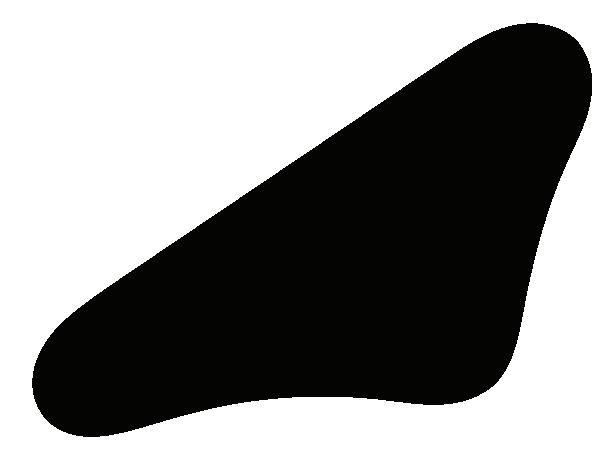

Easy-to-apply formulation with minimal dust off during application & handling
Innovating seed treatment technology for over 30 years
1
® registered trademarks of UPL group of companies
The Seed Protection Specialists
SLUGS & SNAILS LOVE
Maximum Attractiveness
Enhanced Palatability







Faster Efficient Kill
Persistent Control





Innovation. Quality. Solutions. ®Metarex Inov and Colzactive are registered trademarks of De Sangosse SA. 220428
IT TO METAREX INOV All Weather Slug & Snail Bait is developed from science & nature to provide superior control based on unique technology for enhanced delivery.
METAREX INOV GIVES A QUICK, EFFECTIVE KILL
Elders Horticultural Agronomist Glenn Masterton from Shepparton explains the effectiveness of Metarex Inov in managing snail populations.
Smaller baits are IPM-friendly
“Our growers have used Metarex Inov in kiwis, apples and wine grapes. The low application rate has had fantastic results. There is less active going out per hectare as such which helps with IPM, soil biology and worm activity. But it still has good attractant and good killing ability. The growers are very happy with it.”
Over 100 dead snails per square metre
“Metarex Inov gives a quick effective kill. Growers are seeing dead snails in the field. The mortality rate is very high. In pome fruit crops this year we were seeing over 100 dead snails per square metre.”
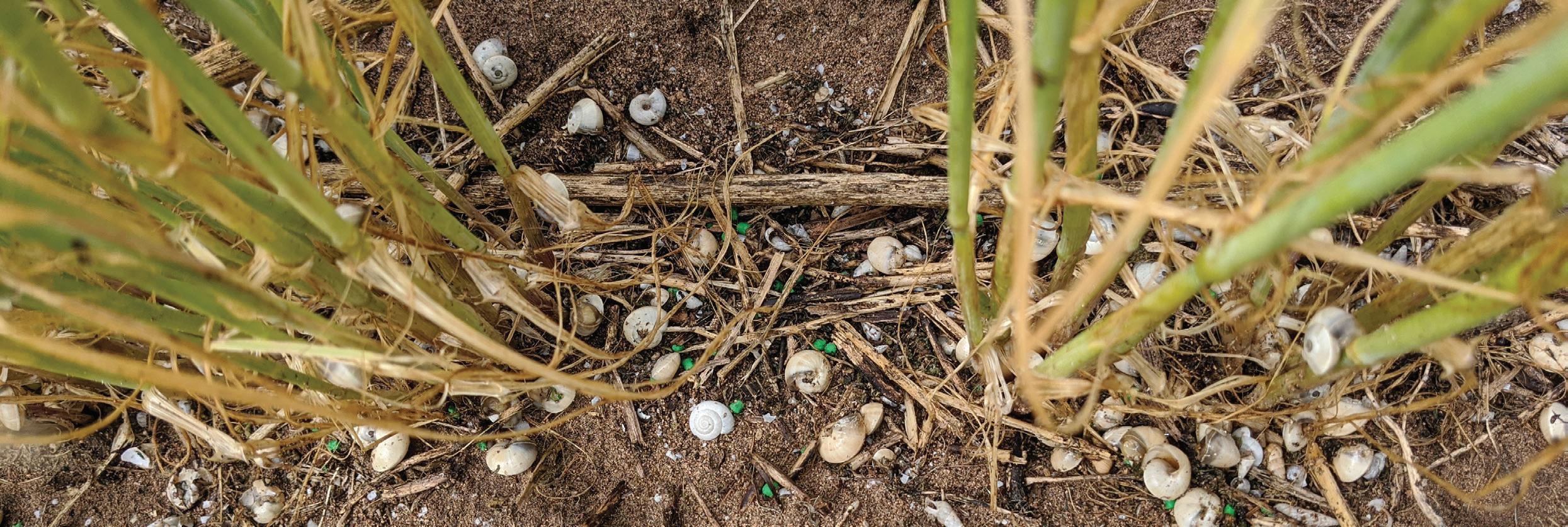
Snails prefer Metarex Inov over tender green shoots

“The attractant is powerful. One grower said he had snails on the actual bag even before he got it out of the shed!
“In the tree crops, once the snails get up into the trees, they are hard to target. They chew the new shoots. Young trees can get very badly damaged and defoliated.
“The beauty with Metarex Inov is that, due to the strong attractant, snails ingest the bait and we’re getting very high mortality rates.
“If snails are still in the vines or fruit trees at harvest time, they can potentially
contaminate a whole bin or trailer load of harvested product. Metarex Inov has helped our growers get cleaner pestfree harvested crops.”
Holds up well under irrigation and rainfall
“In vines and tree crops we’ve got irrigation. When we don’t have rain, we irrigate weekly.
“So we are wetting these baits and they are drying and rewetting. This product’s ability to withstand this is a huge benefit.
“I’d say the pellets last around 2-3 weeks under irrigation. So the attractant and the bait keep working over a longer period.”
Easy to use
“It’s easy and quick to spread. We spread it through the whole floor bed, both the rows and the inter-rows. It worked very well. It goes on at 5 kg per hectare. The 10 kg bag is easy to store and handle on farm and meets OHS standards.
“The palatability and the attractiveness work together. You get a very high kill rate.”
Plan ahead and lighten the pest load
“Next year we will look at an autumn application so we can break the snail’s life cycle. We want to stop them laying eggs. That way we won’t have to manage such a high density of snails come spring. We’ll need to get some good monitoring happening too.”
33 Crop Protection
FMC CORPORATION RAISES FUNDS FOR ROYAL FLYING DOCTOR SERVICE FOR FIFTH CONSECUTIVE YEAR
Sydney, December 19, 2022 – FMC Corporation, an agricultural sciences company, has joined forces with rural retail stores across Australia to donate almost $70,000 to the Queensland section of the Royal Flying Doctor Service (RFDS) through the promotion of FMC’s Graslan® Aerial3D® HiLoad herbicide.
FMC’s Graslan® herbicide promotion ran from May to October 2022, donating to the RFDS for every tonne of product sold in participating outlets. Now into its fifth year of the promotion, the donated amount of $68,293 surpasses FMC’s previous annual donation by over 40 percent this season.

“A special thanks to Queensland graziers for their continued support of FMC’s aerial service of Graslan® herbicide, and also thanks to Elders and other retail partners in north and central Queensland who participated. Their local experience and support of this promotion year-on-year allows us to contribute to the great work that the RFDS does in their communities,” said
FMC Area Business Manager Andrew Burrows.
RFDS has been a cause close to the hearts of the FMC team who live and work in regional Queensland and who believe it is essential to keep the Flying Doctor flying.
RFDS Townsville Nurse Manager Elizabeth Ferrier thanked FMC for its ongoing support, “The services we provide could not exist without the generosity of supporters like FMC, who have now raised a total of more than $146,000 for the Flying Doctor in Queensland. Donations such as these are critical in helping us continue to deliver and expand services, have the latest medical equipment and supplies,
invest in new aircraft and infrastructure, and deliver first-class training for our crews – ensuring we can continue to provide life-saving care for regional, rural, and remote communities, yearround.”
“By donating to the RFDS, we know the money is benefitting people in rural and remote communities, and that we are helping to overcome the barriers to healthcare access that many regional Australians face. We look forward to being able to match or better this year’s donation next season with another Graslan® Aerial3D® HiLoad promotion, continuing our support of this vital work to assist those that live in country Australia,” said Burrows.
About FMC
34 elders.com.au News
FMC
Corporation is a global agricultural sciences company dedicated to helping growers produce food, feed, fiber and fuel for an expanding world population while adapting to a changing environment. FMC’s innovative crop protection solutions – including biologicals, crop nutrition, digital and precision agriculture – enable growers, crop advisers and turf and pest management professionals to address their toughest challenges economically while protecting the environment. With approximately 6,400 employees at more than 100 sites worldwide, FMC is committed to discovering new herbicide, insecticide and fungicide active ingredients, product formulations and pioneering technologies that are consistently better for the planet. Visit FMC Australia - Welcome (fmccrop.com.au) to learn more and follow FMC Australia on Facebook®, LinkedIn® and Twitter®.
Get more grass with GraslanTM
Easy to treat fencelines. Easy to treat thick regrowth. Easy to treat scattered clumps.

Easy to Control Problem Regrowth


The GraslanTM 20kg pack provides clean-up assistance on most grazing properties for use around fencelines, stockyards, holding pens or dams.

• No liquid to mix, no guns to clog and no water needed.
• A dispenser is available that measures an amount of product into the hand each time the handle is clicked. The pellets can then be easily tossed accurately over regrowth.
• GraslanTM has a long shelf life, it can be kept and used at any time.
• It is the easy way to control small-scale regrowth up to 1 m tall.


• Wide window of application.
• Ideal for fencelines and difficult to access areas.
35
FMC Australasia Pty Ltd Phone: 1800 066 355 www.fmccrop.com.au 10/2021
Control Prickly Acacia
Control Currant bush
Control Mimosa bush (Permit 13891)
PERFECT CHOICE FOR OFF-SHEARS OR LONG WOOL
For the control of Spinosad-susceptible lice (Bovicola ovis), including strains resistant to Synthetic Pyrethroids (SPs), in sheep up to 7 days off-shears and sheep with long wool.


For more information, visit pastoralag.com.au
elders.com.au
EXCLUSIVELY AVAILABLE FROM
LICE CONTROL 5L BACKPACK 20L DRUM
RESILIENT
WOOL GROWERS TAKE OUT TOP AWARD AFTER 140 YEARS ON THE LAND
On the outskirts of Morgan in the southern pastoral area of South Australia, you’ll find sheep farming enterprise Wonga Pastoral Company.
F.W. Lindner settled Wonga in the 1880s on a lease of just 200 hectares. With many predecessors driven away by drought, skilful and careful management of Wonga has allowed the property to grow to over 50,000 hectares with a capacity of over 15,000 sheep.
Wonga is still very much a family affair, owned and managed by the Lindner family today. Third generation farmer John Lindner, along with wife Ronda, and their two sons, Will and David, operate a partnership which has seen tremendous success, particularly in their wool production.

Wonga’s first clip came off in 1929 and was sold by the Lindner family through Goldsbrough Mort & Company, prior to merging with Elders.
93 years on, and after achieving Clip of the Sale on at least 10 different occasions, Wonga took out Elders’ SA Supreme Clip of the Year for 2021/22.
Upon accepting the award, John commented how proud he was to finally take out the top gong.
“We have been growing wool and selling it for a long time, and have now achieved our objective, which was to come out on top,” he said. “We look forward to future years in the sheds.”
Wonga’s wool was selected from a pool of nearly 1200 SA clips, scoring 92.4 out of a possible 100 points. The clip, bred by the Lindners from Eyre Peninsula-based White River rams, stood out for its style, bloom and general presentation. It also tested extremely well, with a coefficient of variation of 13.3 per cent for its evenness of length, an average tensile staple strength of 40.2 Newtons per kilotex, and a 39 per cent mid break point.
Perhaps one of the most remarkable qualities of the wool was the fact that it was grown on just four inches of rain.
David Lindner explained that a lack of rainfall is not ideal for their business, but can provide some surprising benefits, such as evenly grown wool.
“Only having four inches, you don’t experience those spikes of rainfall during the year that make the wool grow faster or slower,” he said.
“This can be an advantage as it means your tensile strength becomes quite good.
“Also, being such a dry year, we grew limited feed, and therefore didn’t have much burr or seed in the wool, which lifts your yield.”
Will said that despite these benefits, dry years are very hard on the family’s morale.
“You slowly see your land deteriorate, before your eyes, and there is nothing you can do about it. You just have to wait for the rain.”
And rain it did. Thankfully, since taking out the Clip of the Year, the Lindners have had approximately ten inches of rain; their whole average annual rainfall in just ten weeks.
David said this has been essential to bring the country back to life.
“It gives us a really good ground cover, bringing back our native grasses.
“To see the country recover, it’s going to be great for us long term, because it has time to bounce back before the sheep put grasses under pressure again.”
Although the temptation to quickly graze sheep on the renewed pastures is high, the Lindner family love to see their land looked after, with a genuine focus on sustainability in their operations.
“We do much better long-term by letting our land recover,” David said. “That certainly puts pressure on the business side, but it all pays off in future years.”
37
CANOLA ESTABLISHMENT NOW ‘CHILD’S PLAY’ AT YERECOIN
Having already ameliorated and spaded all his cropping country, Yerecoin grower Richard Field now considers a moisture retention agent at seeding the next key step for improving cropping productivity in difficult soils.
“With canola especially, we have always struggled to get it up, whereas now going forward, it will be like child’s play really,’’ Richard said.
“You just get full, even rows from one end to the other wherever you use it, so it will give us complete confidence when we get marginal starts to a season.’’
Richard, together with a strong team working at ‘Kintamani Farms’, continuously crop 6,700 hectares, including a newly acquired property near Lake Ninan, to wheat, barley, canola and oaten hay, although the latter was excluded from the program this season due to market conditions.
The properties feature soils ranging from sandplain through to good medium loams, clays and gravels, with the Lake Ninan property responding well this season to earlier applications of lime and gypsum.
Richard said he trialled the SE14™ soil moisture attraction and retention agent from DKSH, (previously known as SACOA) last year over 300ha of non-wetting land sown to barley and it helped to achieve a 100 per cent germination strike. This prompted applications throughout all of the canola and 800ha of barley sown this season, once the seeding rig was reconfigured to accommodate the moisture agent.
“Last year, we were not set up to do big areas with SE14™ – it was a big effort just to do the trial. But once we saw the response, we invested in additional equipment to do it properly,’’ Richard said.
Initially, the SE14™ was banded under the seed at 3 litres/ha in 80L/ha of water via their existing John Deere C650 tow-between liquid cart, displacing Flexi-N liquid nitrogen fertiliser and, hence, requiring topdressing of urea.
Trailing a reconfigured, 14,000L Ausplow cart behind the 18-metre Ausplow DBS bar allowed for the banding of both products this season.
The bar includes a standard knifepoint and
press wheel system and features a Furrow Management Systems Australia kit for the SE14™ delivery.
All fertiliser is deep banded below the seed, with Richard preferring to avoid the risk of seedling toxicity, particularly considering seed costs of around $40 per kilogram for hybrid canola varieties.

Flexi-N is typically applied at 100L/ha, although this was reduced to 80L/ha this season due to the rise in fertiliser prices. Similarly, instead of receiving 80kg/ha of mono-ammonium phosphate (MAP) fertiliser, crops were sown with a fertiliser blend comprising 70kg/ha of MAP and 25kg/ha of muriate of potash.
Strong copper and zinc usage previously has prevented further use of those trace elements, however manganese deficiencies are addressed through applications with the Flexi-N, which also acts as a carrier for fungicides.
Seed rates are 80kg/ha for the wheat and barley and 2.1kg/ha with the canola, however Richard said due to the magnificent canola establishment since applying SE14™, this seed rate could be reduced.
“We applied it with about 250ha of canola on horrible non-wetting country on the west side of the new farm and we got a perfect stand of canola that we (otherwise) never would have got.’’
“The canola on the home farm is on non-wetting sandplain and gravels and the 800ha of barley is on awful non-wetting sandplain, where we got 100pc strike and it is thick and even.’’
He said the barley compared very favourably with about 1000ha on the other side of the road where SE14™ was not applied.
Some of the canola bounced out of the ground after seeding on March 15 earlier this year, which Richard said would not have occurred without the use of SE14™.
“We planted about 20pc of the canola before the cyclone to see what it looked like. We only got about 15 millimetres, but it was enough to get the crop going. It flowered about six weeks before the rest of the canola, which was sown around mid-April.’’
“Sometimes we have had to wait for a big rainfall event in May to get the canola up, so you could just miss out if it gets too late and there is a hot finish and you are dropping flowers. You want to flower in the cooler window.
“I feel now we have got all the tools in the armoury depending on what conditions are thrown at us. Mid-April will be the aim with the canola, but we won’t let an early rain go if the opportunity presents.
“If you dig it up now, you will see a tube of wet soil that assists the germination and establishment.’’
He said the quick and even crop establishment with SE14™ also provided for good crop competition against weeds and allowed for correct timing of chemical applications.
While the SE14™ will continue to be applied according to the specific soil types in future, Richard expected it would be used with about one-third of his annual cropping program.
“We planted about 20pc of the canola before the cyclone to see what it looked like. We only got about 15 millimetres, but it was enough to get the crop going. It flowered about six weeks before the rest of the canola, which was sown around mid-April.’’
“Sometimes we have had to wait for a big rainfall event in May to get the canola up, so you could just miss out if it gets too late and there is a hot finish and you are dropping flowers. You want to flower in the cooler window.
“I feel now we have got all the tools in the armoury depending on what conditions are thrown at us. Mid-April will be the aim with the canola, but we won’t let an early rain go if the opportunity presents.
“If you dig it up now, you will see a tube of wet soil that assists the germination and establishment.’’
He said the quick and even crop establishment with SE14™ also provided for good crop competition against weeds and allowed for correct timing of chemical applications.
While the SE14™ will continue to be applied according to the specific soil types in future, Richard expected it would be used with about one-third of his annual cropping program.
38 elders.com.au
SUCCESS FOR KILLARA WITH INVESTMENT IN SUSTAINABILITY
On the outskirts of Quirindi, New South Wales, lies Killara Feedlot, a 20,000-head beef cattle feedlot operated by Elders.
Killara is committed to supplying high-quality beef products, while operating sustainably. The initiatives in place at Killara are wide-ranging, and include measures based in both animal and environmental welfare and best industry practices.
Andrew Talbot, General Manager of Killara, explained that investing in new technology and adopting sustainable practices is crucial for the long-term health of the feedlot and just good business.

“Prioritising environmental and social factors results in better operations overall,” he said.
“As staff safety and community engagement improve and our environment is better looked after, our cattle become healthier and happier.”
One of the most exciting developments is Killara’s involvement in a world-first trial for the early detection of Bovine Respiratory Disease (BRD). Working alongside industry bodies and international universities, it is hoped the findings from the trial will deliver improvements in drug efficacy and animal health across the globe.
Similarly, autogenous vaccine development, targeting the bacteria unique to BRD at Killara has seen vaccines approved and in use at the feedlot. Such vaccines are not yet commercially available in Australia, placing Killara in a unique position to reduce illness and mortality
rates in cattle. Whilst in the early stages, there are positive early signs.
The feedlot has an antimicrobial stewardship plan in place, which is part of the facility’s ambition to reduce antibiotic use in cattle. Killara works closely with cattle suppliers as part of this plan, ensuring cattle are best prepared for feedlot entry, with strong immune response capabilities. The trends in recent years for animal health are positive, with excellent gains being recorded and mortality rates from BRD falling from 1 to 0.5 per cent over the past five years.
There are further plans for milling operations at the feedlot to run predominantly on solar power, which is set to be sourced on-site from a 500 kilowatt solar farm, due for completion in late 2022.
Andrew explained this will reduce Killara’s dependence on electricity from the grid produced by fossil fuels.
“The solar farm is expected to supply most of the electricity used by our mill and potentially export an additional 200MWh of renewable electricity,” he said.
The removal of fossil fuels to power the processing mill at Killara is also underway.
“We are exploring other green energy sources such as hydrogen to power the plant in a clean and sustainable way,” Andrew said. Other initiatives include the establishment of a centre pivot irrigation system to maximise water use efficiency, and a continued focus on
managing nutrient and moisture levels in soil to optimise soil health and productivity.
In the coming months, Killara will be focusing on further developing its understanding of its current soil carbon baseline at Killara and its total farm carbon footprint, to identify more opportunities for improvement.
The initiatives at Killara are part of Elders’ wider commitment to sustainability, as outlined in Elders Eight Point Plan.
Mark Allison, Elders’ Managing Director and CEO said he is pleased to see the initiatives at Killara come to life.
“Sustainability is a core objective of Elders as we continue to operate, grow and support our people and communities,” he said.
“The efforts being made by our team at Killara are proof of this; Elders prioritises and celebrates responsible operations.”
Andrew said he is proud of the leadership that Killara is taking regarding sustainability, explaining that the health of the business is much more than just its profitability.
“The balance sheet of the business is now healthier and more financially sustainable which is great news for all of our stakeholders,” he said.
“But the real health of the business is more than the financial returns; it needs to include the health of the environment, the animals and the engagement of the staff, to ensure that those financial returns are sustainable into the future.”
A solar farm, an antimicrobial stewardship plan and world-first disease detection trials are just some of the measures Elders Killara is implementing to prioritise sustainable operations.
39







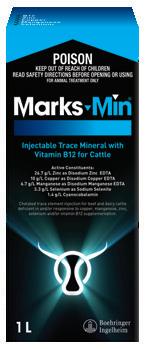




Promotion applies to purchases made within the period 1 March 2023 to 31 May 2023. One (1) claim per transaction and receipt (proof of purchase) throughout the promotion period. ^While stocks last. Offer excludes sheep capsule products. All claims must be submitted prior to 11:59pm, 30 June 2023. Terms & Conditions apply, please visit ahredeem.com.au for more information. See product label for full claim details and directions for use. Boehringer Ingelheim Animal Health Australia Pty. Ltd., Level 1, 78 Waterloo Road, North Ryde NSW 2113 Australia. ABN 53 071 187 285. ®MARKS-MIN, EPRINEX, IVOMEC, AVOMEC, TRIGUARD and FENNEC are registered trademarks of the Boehringer Ingelheim Group. AU-BOV-0068-2022 Brighten up your Autumn with a High Intensity LED Torch Purchase greater than $2,500 excl. GST of products from the Boehringer Ingelheim parasiticides and nutrition range. Keep a copy of your receipt. Visit www.ahredeem.com.au/2023AutumnPromo and follow the prompts to submit your claim. The bonus item will be mailed directly to your address. 1. 2. 3. 4. How to claim your gift PROMOTION PERIOD 1 March 2023 to 31 May 2023^ Purchase $2,500 (excl. GST) of Boehringer Ingelheim products in one transaction and claim an Olight® Marauder 2 – 14000 Lumens High Intensity LED Large Torch valued at $434.95
MONEY IN MINERAL BOOST FOR CATTLE
Cattle producers are reaping the benefits of improved herd fertility, increased weight gain and fewer stock losses thanks to the strategic use of a trace mineral injection.
Marks-Min optimises trace mineral and vitamin B12 levels in a single dose, delivering vital time and labour savings on farms.
Ballarat, Victoria cattle producer David Wells now sells heavier steers and heifers after optimising trace minerals and B12 with Marks-Min.
A total of 280 animals benefited from receiving four trace minerals and B12 in one dose.
“We weighed them at marking and recorded their weights over nine months,” David said.
“The heifers increased by 11.6 kilos over that time period and the steers increased 8.6 kilos.”
David sells all his steers and excess heifers as weaners, so maximising weight gain improves his bottom line.
“Getting the growth rates up quicker and finishing them quicker reduces our costs and increases our production income,” he said.
Woonallee Simmentals and Baker Group Director Tom Baker at Furner, uses MarksMin to save time without compromising animal health outcomes.
“Combining trace minerals with B12 in a single dose allowed us to reduce an injection while getting the same benefit,” he said.
“We were giving multiple needles for other treatments, so reducing an injection means
we can save on labour and time, making it user friendly and cost effective.”
Marks-Min is Australia’s only injectable for cattle that includes vitamin B12 plus four trace minerals – copper, manganese, zinc and selenium – in a single dose.
Tom said supplementing his cattle’s copper and zinc was crucial because the region’s soil is deficient in these trace minerals. And he’s noted the improvement in cattle health.
“We have noticed the cleaning-up of the coat and the orange tip in the coat of our black and red cattle darkening,” he said.
“With this overall improved calf health, we are seeing less respiratory issues and less scours.”
Getting the most out of feeder cattle in the cold Mount Gambier winter has been a priority for Benara Pastoral Company Farm Manager, Brad Creek.

He uses Marks-Min to boost minerals important for the immune system of these animals to maximise per hectare production – even when there’s limited pasture available.
It’s the same situation for the company’s breeders. Treating cows once a year, prejoining, has improved pregnancy rates and enabled the females to thrive – regardless of seasonal conditions.
“We are finding our preg-test numbers have been up since doing a pre-joining treatment,” he said.
“At joining time – early autumn – the feed is short, and the cows are doing it tough, I feel they really get a benefit from the trace minerals.”
Steer calves at Benara Pastoral receive a Marks-Min injection and vitamin A, D and E at their second vaccination and another Marks-Min at weaning. Heifers receive the same treatment and an additional MarksMin pre-joining. Bulls are treated with Marks-Min 60 days before the beginning of joining.
Boehringer Ingelheim Livestock Technical Services Manager, Dr Gareth Kelly, said an animal’s need for trace minerals and vitamin B12 can be intensified at times of rapid growth, reproduction, or stress – such as feed restriction, transport, or entry into a feedlot.
And in some cases, the trace minerals in soil consumed via direct grazing aren’t enough to optimise productivity, and supplementing through feed or orally isn’t always efficient or accurate.
“There’s variation in individual intake, low absorption from the digestive system and competition with other dietary components, limiting the success of a supplementation program,” Gareth said.
“Using injectable mineral supplementation can avoid these variables by being rapidly absorbed into the bloodstream and made readily available to support optimal health and production. Minerals not immediately required are stored in the liver and mobilised as required.”
41
ANIMAL PERFORMANCE ACCELERATES
Easier access to animal performance data and the ability to easily monitor and edit this data is becoming increasingly important as producers face ever increasing demands on their time. Better data and easier ways to use it also allow for better management decisions.
Gallagher have recently released a significant software update for their TW/ TWR range of weigh scales and Animal Performance cloud-based software that improve the already great offering.
Mike Hemsley, Business Development Manager for
Animal Performance and Traceability at Gallagher said, “The range of updates to our software will provide a variety of new measures, allowing users to more easily, and more comprehensively, manage their Animal Performance and Traceability”.
Mr Hemsley is particularly excited about the benefits for producers from new features such as having a full animal history available on your mobile phone. This brings a level of flexibility not previously available.
Some of the new features in the TW/ TWR weigh scales range include the ability to:
> Edit locked Weights
> Record Treatments including batch number and expiry (TW-3 and TWR5 models)
> Draft by Rules and apply that across the Session
> Utilise Animal Hold whilst drafting
> Add and edit Sessions
In the full subscription Animal Performance APP/Software some of the new features include:
> Access to Groups including viewing, editing and deleting
> Perform NLIS actions within Groups
> Ability to rename Sessions (also available in the free version)
> View animal history in a similar fashion to online software
The combination of these features makes the cloud application and TW/TWR range more powerful than ever, providing enhanced tools for producers to manage traceability and animal performance. The continuing evolution of tools within the suite of products and software is indicative of the new name for this category, “Animal Performance and Traceability” that replaces the former name of “Weighing and Electronic Identification”.
Mr Hemsley explained that as this segment has evolved over the years, it has moved beyond just weighing and tracking EID’s, to providing the ability to record and monitor many variable animal performance traits. It provides a rich history of the performance of animals and tools to make better animal management decisions.
The new name of “Animal Performance and Traceability” better reflects both
what the hardware and software suite can do and the development of future features. This category is aimed at helping producers make easier and better-informed decisions in their livestock operations.

“Gallagher is committed to supporting our customers with smarter, simpler solutions that make farm life easier and more profitable. We’re working with our reseller partners to solve problems in smarter ways, integrating data, and making an impact for end users.” Mr Hemsley said.
To access the new features within the weigh scales and full version of the Animal Performance App, current users need only perform a software update on their weigh scale and software. For users of the free version of the Animal Performance App, upgrading to the full paid version will unlock the features.
To view the range of Animal Performance and Traceability options and help your producers make better informed decisions, visit Gallagher at the major field days happening across the country this year or talk to your local Territory Manager.
Existing users looking for assistance with updating software can also call the Gallagher Customer Support Team on 1800 425 524. This is a dedicated team fore providing product and technical support.
Ag Tech
42 elders.com.au
A better view of your animals.
Animal Performance
Web & mobile app


Take control of animal production with an all-in-one hardware and software solution that allows you to track livestock performance, make better decisions and grow your profit.

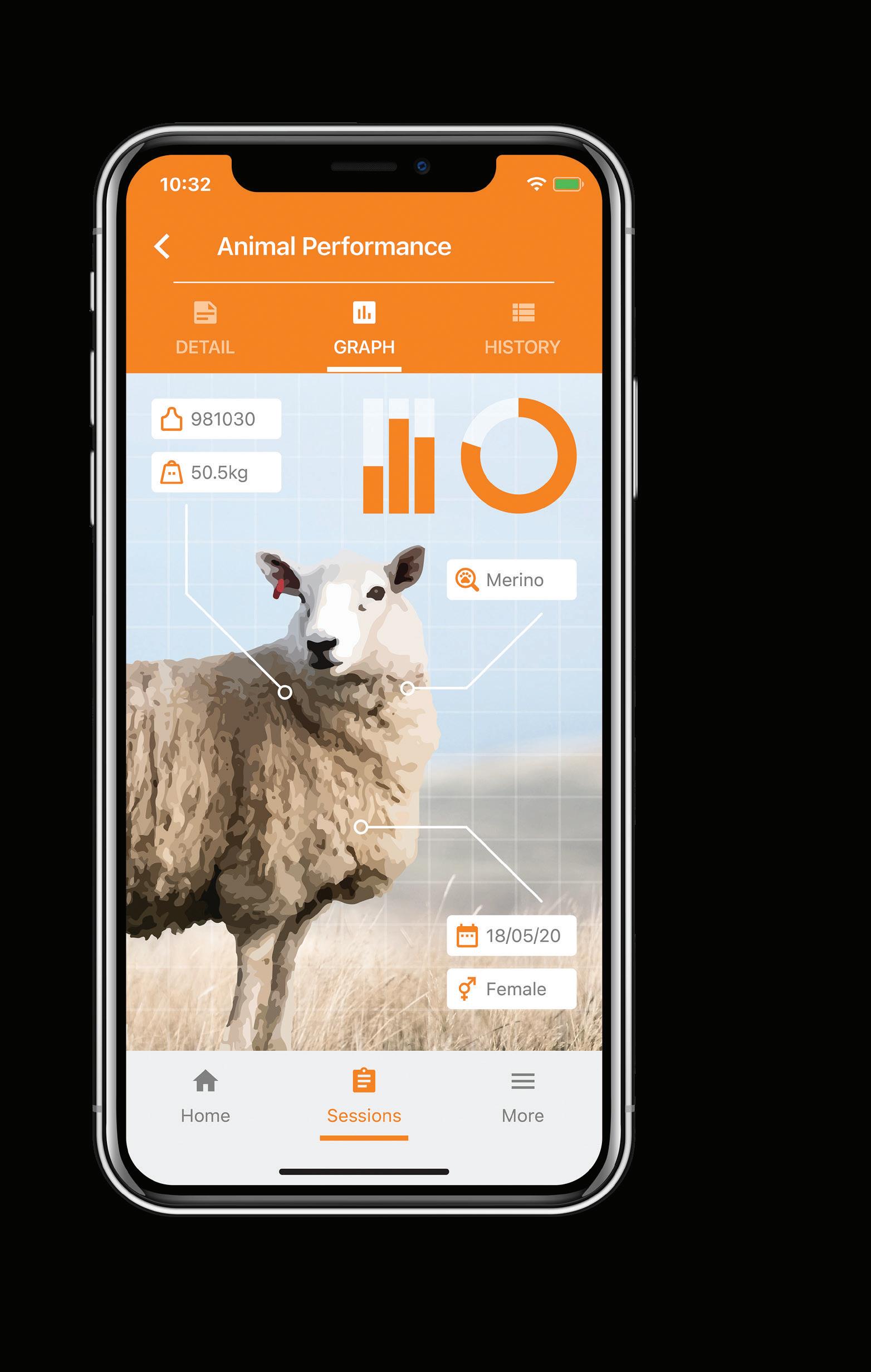

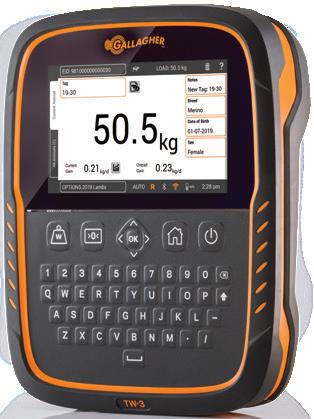
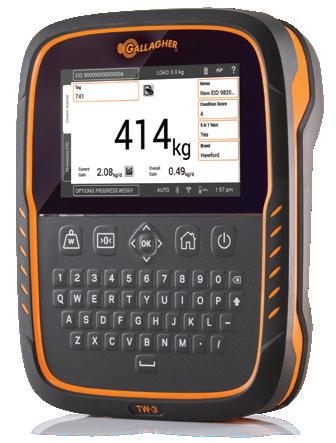
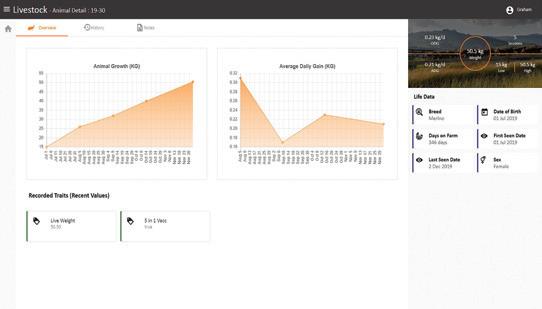
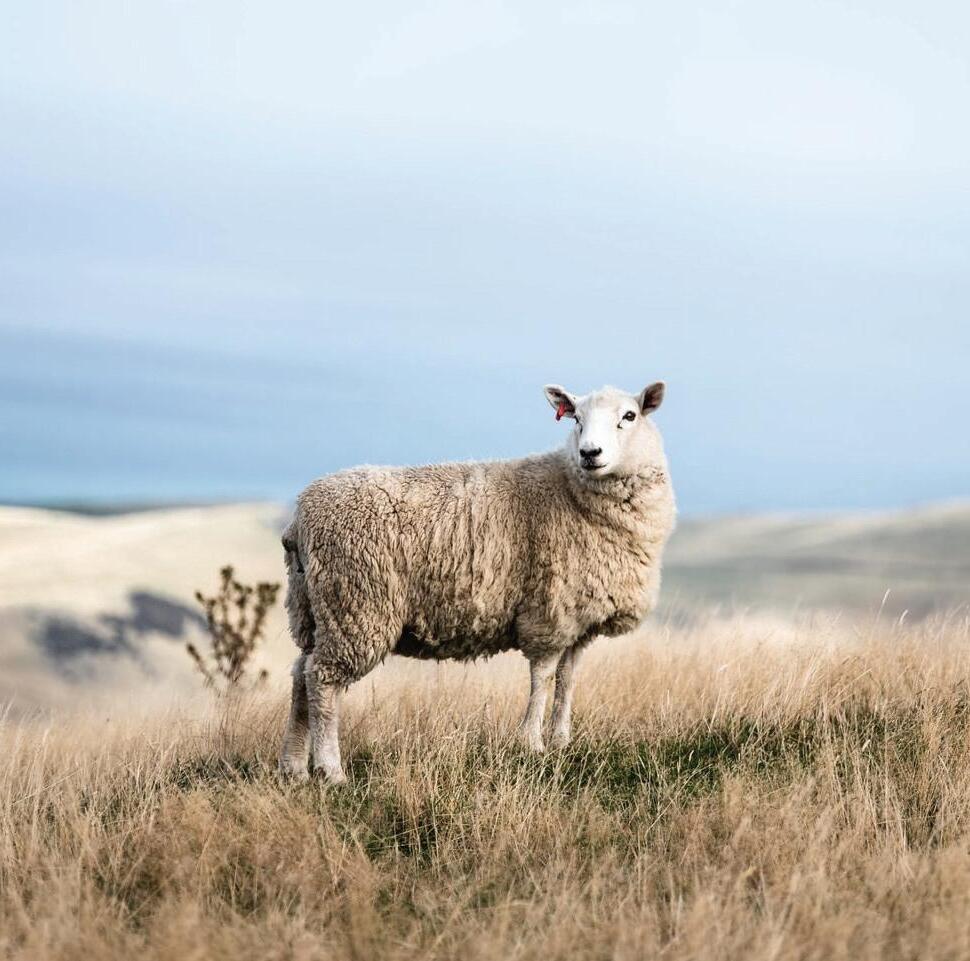
Discover more at am.gallagher.com
LEARN MORE




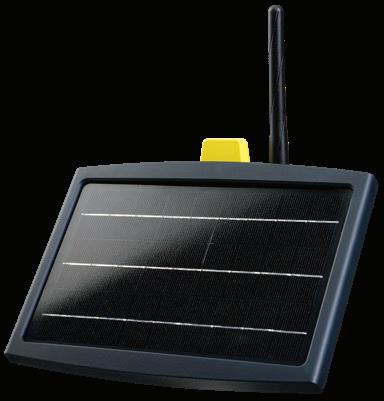

Check the weather Check your emails Check on your fences Get peace of mind no matter where you are with the world’s leading Fence Monitoring System Scan for more information or visit farmingmadebetter.com Tru-Test Farm Network Fence Monitoring System Digitally monitor voltage on different points of your fence in real time, via our Datamars Livestock: Farm App. Enjoy peace of mind of knowing that your livestock or crops are secure, freeing you up for your other farm jobs.
SYSTEM
Smart technologies are on the rise around the world. Now Australian producers have great access to new smart tools helping them make swift decisions about their land, water, crops, and animals from anywhere in the world – all based on real time information.
A perfect example of the latest smart technology in the market is the new Tru-Test Farm Network Fence Monitoring Solution. A smart fence monitoring network solution launched in 2022 by Datamars Livestock.
The Tru-Test Farm Network Fence Monitoring systems provides continuous remote voltage monitoring on multiple parts of a fence system.
How does it work? The new Tru-Test system uses a mesh network of fence nodes which delivers up to 12,000V across electrified wires 24 hours a day, all year round. The system monitors the full length of the wire not just the voltage at the end. If and when the voltage at any part of the line drops below the set figure, it sends real time alerts to one or more cell phones.
South Australian farmer, Charlie Crozier is almost at the end of his first full season with the system. He runs nine nodes across the farm monitoring two paddocks at a time.
Charlie runs a self-replacing flow of 2000 Dorper breeding ewes at Narree
Downs. Prior to installing the Tru-Test Fencing Monitoring, he would manually test his 300kms of extensive electric fencing three times a week as he moved around the farm, to detect any weakness.
Now he has no need to drive across the 840-hectare property, then walk the fence line to check the voltage. His fence data, relayed to the Cloud every two minutes, is already on hand no matter where he is on or off the property. If voltage dips or drops away, Charlie is alerted via an app where he can see all the current real time and older historical data about what’s been happening along the line.
Charlie estimates a time saving of 30mins every day that no longer needs to be committed to regular fence checks.
It’s time that he can put elsewhere, which in mind makes the monitoring system “a really valuable investment.”
“It’s not a toy, it’s a tool” he says and its absolute peace of mind.
The Tru-Test Farm Network Fence Monitoring system’s reliability makes it an ideal technology to monitor remote blocks, run offs and waterways
and it continues to transmit accurate information even when the fence condition is poor.
It is perfect for monitoring multiple paddocks simultaneously and large tracts of land. A total of 50 nodes can be used across one farm network with nodes up to 500 metres apart within line of site. The multi-hope system relays voltage data over long stretches giving producers extensive coverage. Single nodes can also be added supplement the main infrastructure to keep a finger on the pulse of temporary break fencing. Connectivity is a good question. The system communicates via radio frequency. If a farmhouse has internet, the central network gateway can be located within its Wi-Fi range or connected with an ethernet cable and the whole system is brand agnostic which means it can pair with any energizer.
To find out more about Tru-Test Fence Monitoring systems visit your local Elders branch or give the Datamars
Livestock team a call on 1800 641 324

45 Fencing
GET PEACE OF MIND NO MATTER WHERE YOU ARE WITH THE WORLD’S LEADING FENCE MONITORING
SOW CERTAINTY ON FARM WITH PROVEN ENDOPHYTE
Endophytes can take pasture performance and persistence to the next level by protecting pastures from insects after your seed treatment wears off.
"While a pasture seed treatment such as Ultrastrike® will protect your pasture from insects during establishment (0-6 weeks), an endophyte provides the plant with protection from eight weeks onwards," says Isaac Berry, DLF Seeds Product Development Manager.
An endophyte is a fungus found naturally in many grass species, including ryegrass. It protects the plant from insects; in return, it offers the endophyte a place to live and reproduce.
Tim Calder, a farmer from Meeniyan Victoria, has had great success protecting his pasture against African Black Beetle with AR37 endophyte. "Several years ago, African Black Beetle appeared on our farm, decimating our Italian and some permanent ryegrass pastures which brought about a change in pasture variety selection on our farm.
I wanted a tetraploid perennial that was persistent, palatable and responsive to summer and early autumn rains. Having evaluated several varieties on our farm, I now use Base tetraploid perennial ryegrass with AR37 endophyte almost exclusively in our pasture improvement programme. A particular feature of it is its persistency (I have many paddocks untouched for over five years) and its ability to maintain feed quality into the early summer. It has also been a reliable performer in producing good quality silage in large quantities with up to three cuts on some out paddocks." explains Tim.
DLF Seeds have been the leaders in bringing to market novel endophytes (such as AR37), to provide farmers with insect control, improved animal safety and animal productivity and increased dry matter performance over standard “wild” type endophyte.
We have supplied the market with novel endophytic grasses for over 20 years, and developed the research, knowledge and understanding of how to ensure we deliver viable endophyte (percentage of live endophyte) in the seed we supply. Viable endophyte means that the grass will provide the level of insect protection we expect.
AR37 endophyte has been sown on Australian farms for over 15 years, taking ryegrass pasture persistence and protection to a premium level by controlling insects such as Argentine Stem Weevil larvae, Pasture Mealy Bug, adult Black Beetle and Root Aphid.
Offering on farm certainty and ample benefits, AR37 provides farmers with an unbeaten balance of pasture production and persistence higher tiller density over time assistance with post-drought recovery and improved agronomic performance stronger control of more insect pests compared to ryegrass cultivars containing AR1 endophyte or standard endophyte (SE) the potential for greater carcass weight per hectare compared to ryegrass cultivars containing SE greater return on investment increased total dry matter production compared to ryegrasses containing AR1 or no endophyte no Ergovaline (an alkaloid produced by some endophytes) for increased milk production (endophytes containing Ergovaline may impact milk production) increased sheep performance compared to ryegrass cultivars containing SE low incidence of dags in sheep
Victorian farmer Leigh Weston (Wonthaggi) has seen the increase in milk production a highquality ryegrass with a proven endophyte can

offer "Base with AR37 suits our farm and our management style. When the cows come in here, you will get another litre or two in the vat, there's no doubt about it." Explains Leigh.
AR37 is available in perennial ryegrass varieties such as Base and Vast tetraploid perennial ryegrass, Legion, One50, Platform diploid perennial ryegrass and the NEW late heading Reason diploid perennial ryegrass; as well as Mohaka tetraploid hybrid ryegrass
Endophyte technology has advanced significantly since the 1980's and we have continued to help develop novel endophytes which provide the long-term pasture persistence and protection from pests that farmers require, while reducing animal health issues.
High performance varieties containing AR37 endophyte can be found at Elders rural retailers.
For more information on AR37 and other endophytes, contact your local DLF Seeds Sales Agronomist on 1800 619 910 or by visiting dlfseeds.com.au
46 elders.com.au Seed
PERFORMANCE PASTURE SEED WITH AR37 ENDOPHYTE INSECT PROTECTION

WITH OVER 25 YEARS OF EXPERIENCE AND KNOWLEDGE, DLF SEEDS IS YOUR LEADING EXPERT IN ENDOPHYTES
Dairy Australia’s Forage Value Index number 1 performer for 5 consecutive years^
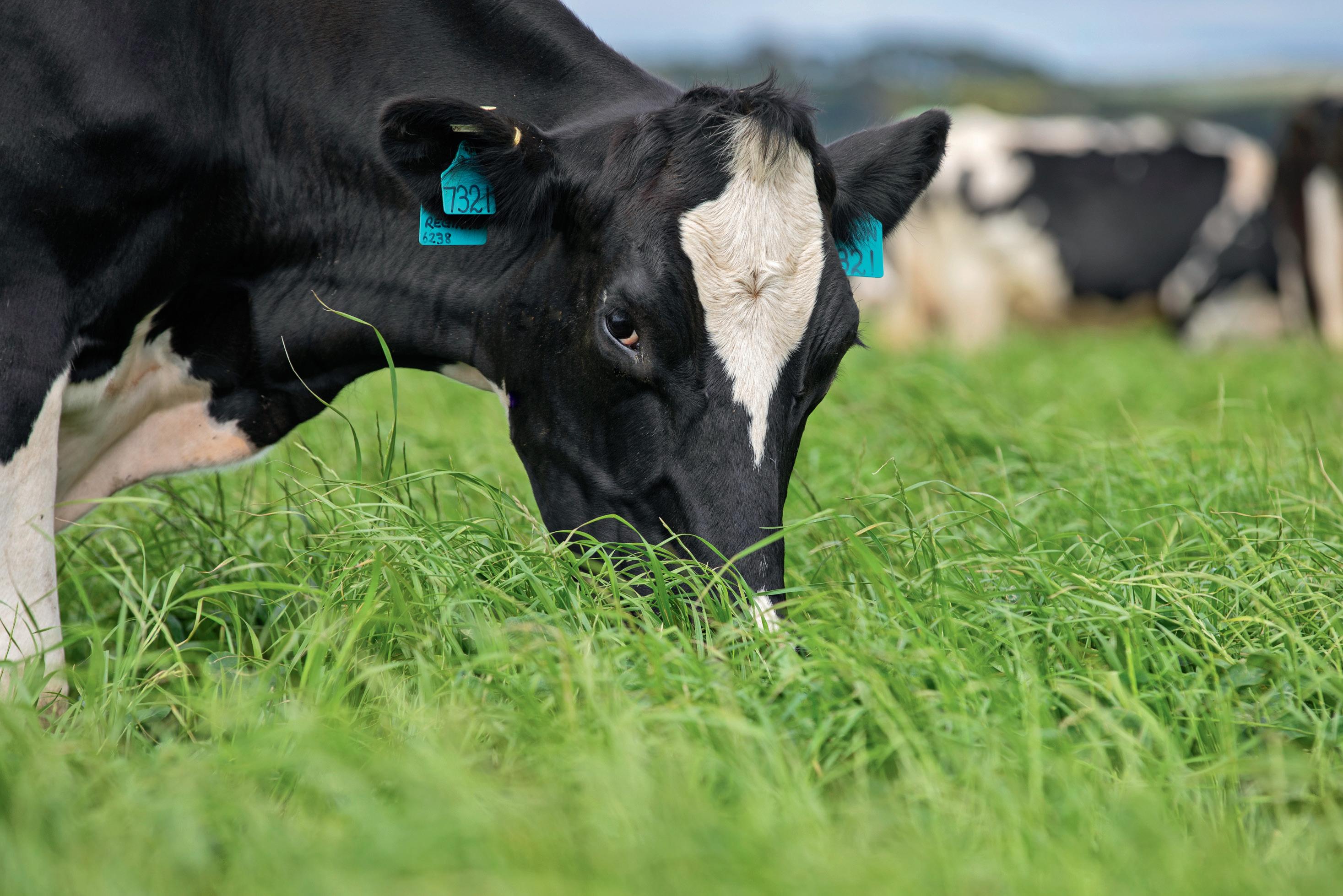
Bred in Australia, Base AR37 provides high performance pastures for sheep, beef and dairy farmers, plus quality hay and silage. With premium insect protection against Argentine Stem Weevil Larvae, Pasture Mealy Bug, Adult Black Beetle and Root Aphid, Base AR37 is the leading perennial ryegrass you can sow with certainty.

Base AR37 tetraploid perennial ryegrass

• Premium insect protection from AR37 endophyte
• Excellent late season quality feed, very high tiller density and high dry matter production
• Increased sheep performance compared to ryegrass cultivars containing standard endophyte (SE)
*Legion AR37 diploid perennial ryegrass
Sow the high performance diploid with outstanding autumn and winter growth. Legion AR37, a complete all rounder in all regions and all seasons.
Mohaka AR37 tetraploid hybrid ryegrass
The hybrid with premium insect protection and high yields. Maintains ground cover for outstanding stand integrity, production and weed suppression.
DLF Seeds varieties available from your local seed retailer.
dlfseeds.com.au | 1800 619 910 ^From 2018 to 2022 *Due to a small number of tip awns, Legion is certified as Lolium boucheanum.
Improved Salt Tolerance
In trials evaluating lucerne cultivars for salt tolerance assessing germination in the laboratory, greenhouse for regrowth potential and forage yields in field production, it was found that SW9720:


Was the leading variety in the field evaluation, producing the highest yield (kg/ ha) in salt conditions of 2131ppm in soil and 2950ppm in irrigation water
Germinated in saline levels up to 20 000ppm
Produced high forage and good regrowth under 3840ppm of irrigation water
www.swseedco.com.au Your partner in the paddock. SW0327
SW9720 Lucerne
NEW S&W LUCERNE HIGHLY WINTER ACTIVE GENETICS
The S&W Lucerne breeding program has a long history of developing highly winter active varieties with outstanding forage yields and quality, with robust pest and disease packages. The current commercial highly winter active portfolio available for customers is no exception.


Over the last five years, the S&W lucerne breeding team has developed new lucerne varieties in the 8 to 10 dormancy ranges that consistently outperform current commercial varieties. The graph shows that customers can produce up to an extra 16% kg DM/ha per year, growing S&W elite varieties, based in the extensive multi-season and multisite evaluation program.
Talk to your Elders agronomist about the best options for your enterprise needs.

49 Seed
ELDERS INGLEWOOD BRANCH MANAGERS GOING
ABOVE AND BEYOND FOR THEIR LOCAL COMMUNITY
Ben and Carissa Hammond, husband and wife duo, from the Elders Inglewood branch are well known locally for their incredible contribution to their community.
Year after year, Ben and Carissa go above and beyond with their time and fundraising efforts to support their local region prosper.
In recognition of their efforts, they were nominated by the Elders QLD/NT State Leadership team for the 2022 One Elders ‘Give It’ award, which recognises those who have gone above and beyond in acts of service to their local community.
When speaking with Ben and Carissa about their community minded values and involvement, Ben commented, “every time an organisation puts their hand out, we put something in it, whether it be support through the Elders branch or our own personal time.”
One initiative that they have been very involved with in the Inglewood region has been combatting rural crime. After a discussion with their local police force, Ben and Carissa realised a gap with the need for the community to engage h the local beat. In collaboration with the Police, they developed a new initiative to help the Force build a relationship with the rural community and to help combat rural crime. New CCTV cameras have been installed in the local area, through the financial generosity of Ben and Carissa.

The pair also held an information night for the local community and police force at the Elders Inglewood Branch, with over 85 people attending. The local sergeant commented that there had been significantly more community engagement with the police and more people coming forward reporting crime incidents after the event, which has subsequently allowed them to better combat rural crime.
This year, Ben and Carissa held their own charity golf day to raise much needed funds for LifeFlight, a service that their community relies upon. With financial support from Elders’ suppliers and other local business sponsors, they had over 30 players attend, raising over $2000 for the organisation. They have also supported other local charity golf days including the Partners in Prostate Awareness (PIPA) golf day with Carissa even donating a piece of artwork she made for the event.
In addition to financial support, they impart much of their own valuable time to the local community. Both Ben and Carissa are members of the Inglewood Show Committee and work tirelessly each year to make sure this is a successful event and attended well by the community. As a part of this they also continue to sponsor the commercial cattle event at the show. This has been essential for the wider event, allowing it to continue to run through tough climatic events such as droughts and floods. Ben and Carissa are also members of their school Parents & Citizens (P&C), which includes being a part of the Trail Bike Committee which saw 440 riders this year and Ben taking over as president for 2023.
During the December 2021 floods, Ben and Carissa worked tirelessly to move all of the Elders merchandise in the Inglewood branch to higher ground
Wanting to keep stock safe due to the impending need for supplies within the community, Ben said, “we certainly did not want to risk putting the community out without this product support during a time of need”
“I think after it all came through, we only lost one single a bag of dog food, which was a good outcome.”
Ben and Carissa also hold local client information evenings at the branch, with one of their events attended by 60 local producers.
“We love engaging with our community especially through these sorts of events,” Ben said.
“We understand the important role that we can play in getting this community together for some networking and education to better our region’s mental health and productivity.”
It’s people like Ben and Carissa, who tirelessly give so much and provide immense value to their local communities, that make our regions special places to be. Congratulations on your nomination, Ben and Carissa – your community is lucky to have you.
50 elders.com.au
This season, you’ll be rewarded in more ways than one when you choose EPG Seeds. You could win a Makita 18V Brushless 12 piece 3X5.0Ah Combo Kit, valued at $2899. Simply purchase one tonne or more of Graza 85 Forage Oats, Graza 53 Forage Oats, Oliver Forage Oats, EG Titanium Wheat or LG Alestar Malt Barley in one transaction, and upload your proof of purchase to enter the draw.

To enter the draw, simply upload your receipt or proof of purchase to www.epgseeds.com.au/rewards by 30 May 2023.

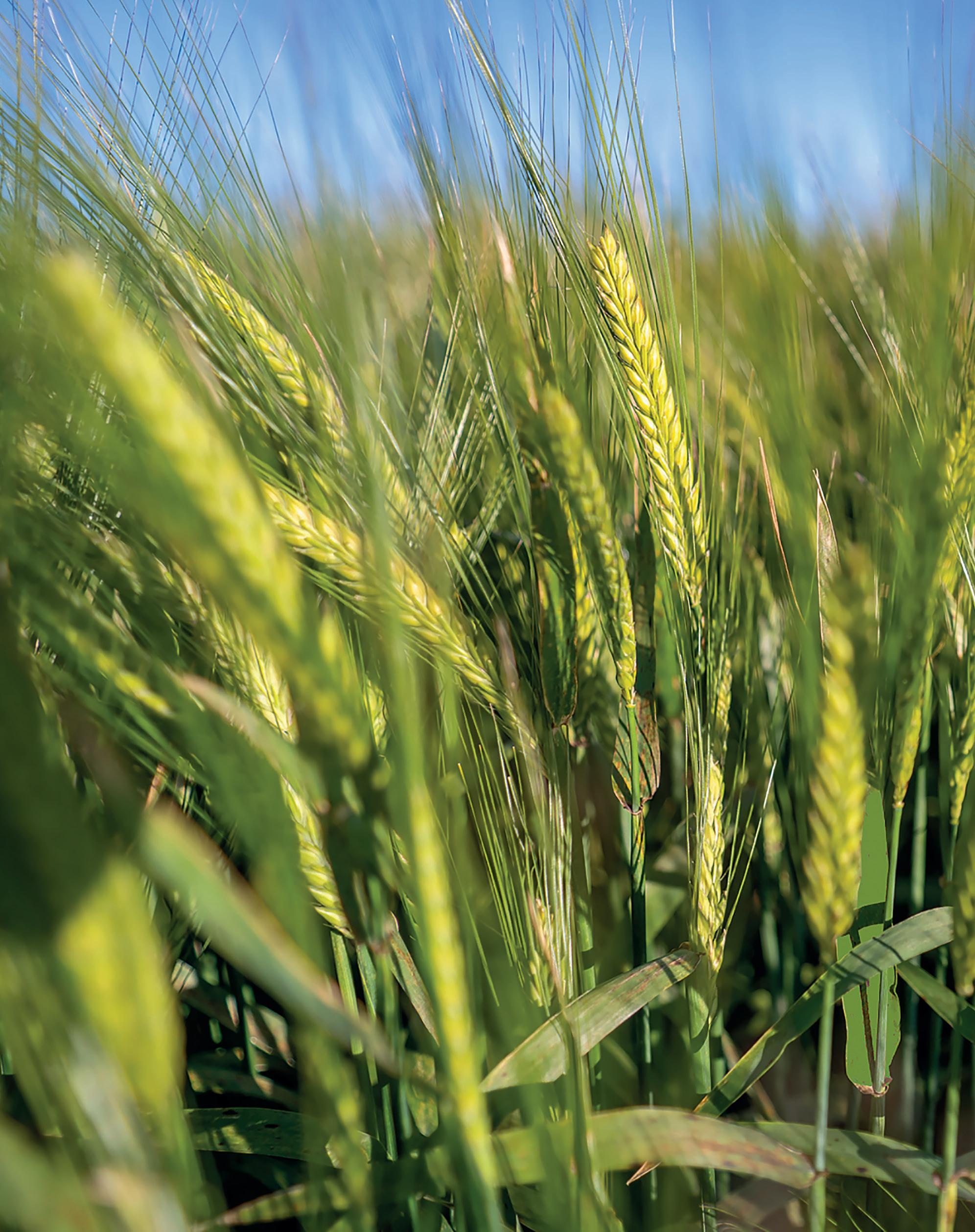
Select EPG Seeds varieties as part of your crop rotation and you could WIN Makita tools. It’s where success starts.
AVAILABLE NATIONALLY FROM ALL R URAL S UPPLIERS. To learn more
epgseeds.com.au/sourcing-seed/find-stockist/ For full terms and conditions visit www.epgseeds.com.au/rewards Promotion period 23/01/2023 - 30/05/2023. Available while stocks last. Eligible products Graza 85 Forage Oats, Graza 53 Forage Oats, Oliver Forage Oats, EG Titanium Wheat or LG Alestar Malt Barley. Not available on split orders. Purchases must be in one transaction. Redemption period 23/01/2023 – 15/06/2023. Proof of purchase receipt/tax invoice required. Promoter Elders Rural Services Australia ABN 72 004 045 121 (Elders), Level 10, 80 Grenfell Street, Adelaide, SA 5000. WIN A MAKITA 10 PIECE COMBO KIT
visit
OP TT varieties offering excellent crop rotation. That’s why I grow N useed


Our range of open pollinated triazine tolerant canola delivers excellent profitability in a range of cropping environments, and has been consistently adopted by growers for its high yield potential, blackleg resistance and excellent weed control. That’s how we offer # ValueBeyondYield

nuseed.com/au
Scan this QR code to view the full range
ARE YOU THINKING ABOUT PLANTING RETAINED HYBRID CANOLA SEED? HERE’S WHAT YOU SHOULD KNOW

With the 2023 planting season approaching canola growers may be considering retaining hybrid seed from their 2022 harvest to plant this year, with the expectation of seeing the same high performance at harvest.
At Nuseed we advise against retaining hybrid seed because retained F2 hybrid seed can have unwanted traits like sterility, a lack of herbicide tolerance and decreased blackleg resistance.
To understand the risks of retaining Hybrid glyphosate tolerant seed, it is worth understanding the complexities behind the canola breeding process to then understand how it can go wrong.

In a canola breeding program, F1 hybrids are produced by crossing two inbred parent lines, an A line (female) and a R line (male) (see figure 1). These parents create the F1 canola hybrid plant that farmers grow. These F1 hybrids express hybridity and improvement in traits such as yield, chemical tolerance, oil, vigour, shatter tolerance and black leg resistance.
The A line carries the Glyphosate tolerance gene (G) and the sterility gene (r) (no pollen)
The R line carries the fertility gene (R) (pollen) and does not carry the glyphosate gene (g)
In crossing the A line (GGrr) and R line (ggRR), breeding companies intend to produce F1 hybrid progeny (GgRr) which results in plants that are uniform and have identical genetic sequencing. These plants carry the glyphosate tolerance gene and the fertility gene so they can fertilise themselves. This is a F1 hybrid and every plant will express the same genetic characteristics, act the same and perform the same. This can be shown in a punnet square (see figure 2). The punnet square
is used to express the fertility/infertility gene and the presence or absence of the chemical tolerance gene.
Retaining the F1 progeny (F2) with the intention to plant, understand the F2 plant has gone through genetic segregation and therefore the crop will lack the uniformity seen in an F1 hybrid. The progeny will also exhibit a range of different genetic sequences across all genetic traits found in canola, not limited to chemical tolerance and sterility.
Through segregation, 25% of the F2 seed will not carry the chemical tolerance gene and will perish when sprayed with glyphosate (see figure 3). Furthermore, 19% of plants will remain sterile and unable to self-fertilise. These sterile plants would require pollination from a plant that is carrying the fertility gene (pollen). This physical transfer of pollen is not reliable and often results in a lower pollen set in the sterile plants leading to significantly fewer seeds per pod and plant.
In the above, only two genetic traits are discussed and compared. The segregation of F2 plants is more complex when all genetic traits in canola are looked at and the variability of each of these segregations can be seen. Progeny from a F1 hybrid plant can start to show increased disparity in maturities, plant height, shatter tolerance and yield. These are all unknowns and increase the risk for potential errors for farmers.
With the retention of F2 hybrid seed, the biggest concern to the canola industry is blackleg disease resistance breaking down. F1 hybrids carry uniform and strong blackleg resistance genetics of both major and minor genes. Breeders can stack these blackleg resistance genes into a hybrid more easily than an open pollinated canola variety, resulting in hybrids with improved blackleg resistance.
Retained F2 seed will have reduced blackleg resistance genetics, both major and minor. These F2 plants will also lack uniformity in the blackleg resistance genes they carry, increasing the risk and likelihood of blackleg breaking in the paddock. The retention of F2 plants can result in all canola blackleg genetics failing in an extremely short time frame. Hybrid seed should not be retained for future planting. The F2 progeny has segregated out to a less vigorous and more variable plant, leading to lower overall yields. Blackleg resistance is reduced in F2 progeny and blackleg groupings will be unknown which can speed up to the potential breaking of canola. The risk of sowing F2 progeny is too high.
For any further information around the retention of hybrid seed and the risks this will introduce to your business as well and the canola industry, please contact your local Nuseed Area Sales Manager.
53 Seed
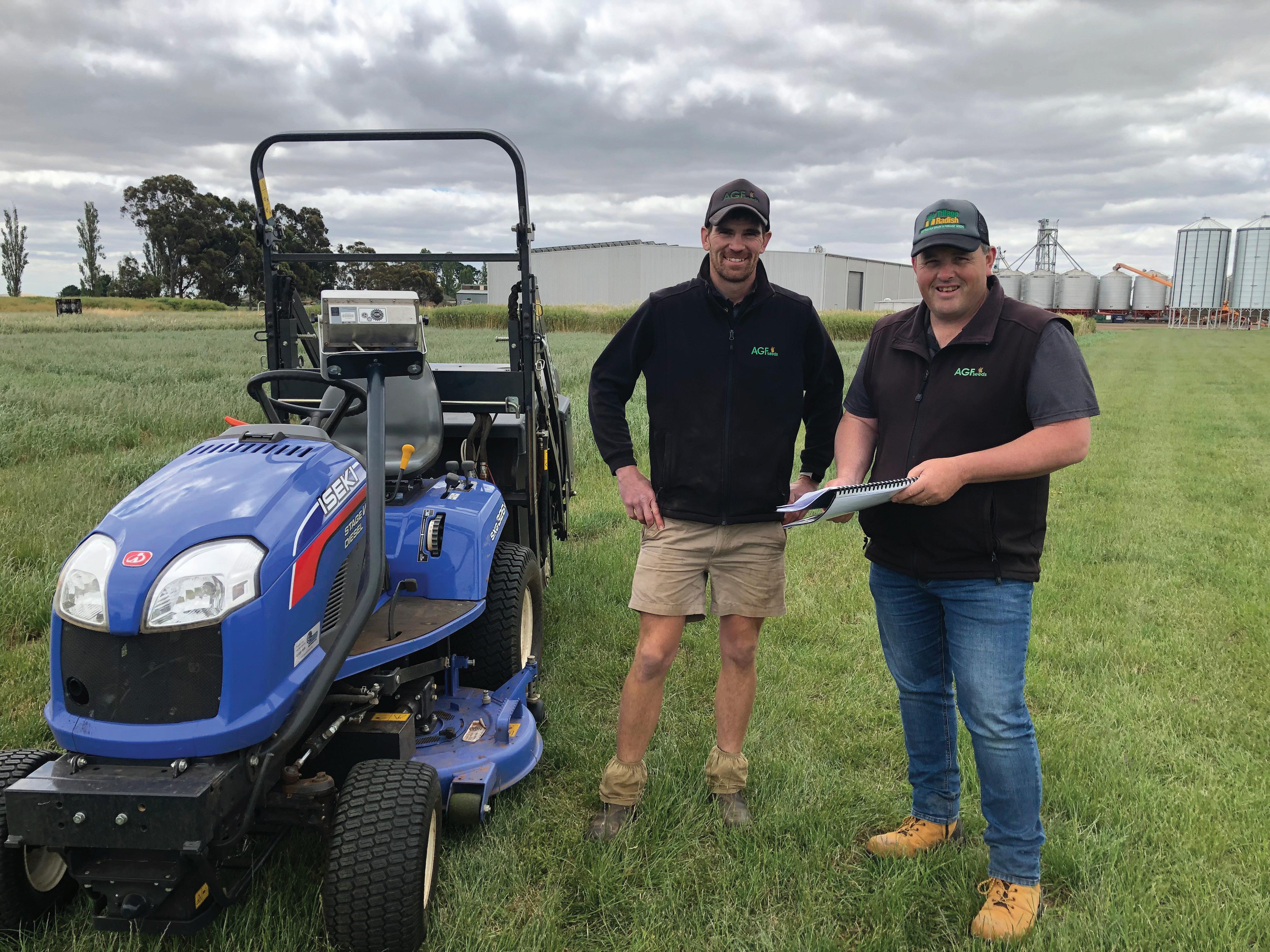




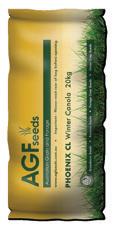



PHOENIX CL Still considered a new crop for Australian growers, Winter Canola adoption is growing rapidly in medium and high rainfall environments. Used in dual purpose (graze & grain) and grain only systems, the big gain for farmers is what the wide sowing window can mean for them. The vernalisation requirement or need for a period of cold weather, allows for much earlier sowing of Canola compared to the With years of experience growing Winter Wheat, AGF Seeds have been evaluating other species with vernalisation requirements, and when sound Blackleg resistance was bred into European Winter Canola varieties, the potential uses in Australia were and higher grain yields have been the focus. Phoenix CL is a leading variety for graze and grain and grain only uses, with traits Our pipeline for Winter Canola varieties with continued improved agronomic performance in Australia is mature. testament to the program the 2024 slated release of Captain CL with increased early biomass and higher grain yields continuing to deliver BLENDS OTHER GRAIN BARLEY CANOLA WHEAT GRAIN HERBS FORAGE PASTURE SOIL HEALTH TILLAGE RADISH PULSES 36 GRAIN BIGRED WHEAT STOCKADE WHEAT REILLY WHEAT KINGSTON WHEAT FANDAGA BARLEY PHOENIX CL CANOLA CAPTAIN CL CANOLA FORAGE & PASTURE TARGET SEED BLENDS HEADSTART FORAGE BLENDS VAMPIRE RYECORN MARLEIGH OATS FORESTER OATS PINNACLE RYEGRASS COVER CROP FARMOUR MULTI-SPECIES AND BIOFUMIGANT BLENDS FREYR SUNN HEMP TILLAGE RADISH LAWN SEED READY TO GROW SEED GUIDE 2023 1st EDITION YOUR COMPREHENSIVE GUIDE TO GRAIN, FORAGE, PASTURE, COVER CROP AND LAWN SEED www.agfseeds.com.au Tel 03 5345 6262 orders@agfseeds.com.au WN D
A FOCUS ON PROCEDURE AND INNOVATION ENSURES SEED QUALITY
AGF Seeds has long followed the mantra that buyers need to get what they’re paying for.
Director David Toose says the company’s intensive quality assurance process is constantly evolving while its commitment to improvement and innovation has never dimmed.
“You need to know what’s written on the outside of the bag is actually in the bag and we have very strong processes in place to make sure that happens,” David said.
AGF Seeds has earned its well-established reputation over many years for selling quality seed and providing expert independent advice to resellers and growers throughout Australia.
The company’s recent expansion with the acquisition of Smyth Seeds has made it one of the leading seed production and marketing businesses in the country, while retaining its status as a 100 per cent Australian family-owned business.

David says AGF Seeds’ focus on quality and innovation is paying off with exciting new products coming to the market.
The company’s six-hectare research and development site at Smeaton in central Victoria is home to hundreds of different trial plots which will yield long-term replacements for the likes of Pinnacle annual ryegrass, BigRed long

season wheat and Tillage Radish. These successful products have all evolved through AGF Seeds’ research and development program.
There are currently about 400 plots of wheat and 100 barley plots in evaluation and variety trials, along with annual, Italian and perennial ryegrasses/other perennial grass species.
“The genetics we’ve got coming through are exceptionally good,” David said. “A real highlight of this season is the quality products we have to sell along with multiple cereal, oilseed and forage lines showing great commercial promise.”
The trials at Smeaton are the first step in the research and development process. Varieties that look promising in this early evaluation work are further tested in multiple locations around Australia.
Quality assurance is integral from before the crop is accepted into the plant to the time it is planted. The modern seed cleaning processing plant at Smeaton complete with gravity table and colour sorter ensures a smooth and safe process.
“We maintain the purity by segregation and careful cleaning,” David said.
“We have strict quality assurance procedures to ensure that everything is clean, that all dust, chaff and weeds are removed, and that certification rules are adhered to. The procedures are continually evolving with new machinery, training of staff and development of strict protocols that everyone follows.”
Cleanliness and good hygiene are essential at all stages from planting, sampling, cleaning, storage, packaging, dispatch and transport.
The approved product is custom mixed or treated and then distributed around Australia using a well-honed transportation system to get the best seeds to end users in a timely manner.
“It’s a painstaking process that starts with finding the right growers and the right products for our conditions and continues until the product is in the hands of the buyer,” David said.
David says that the positive feedback from long-term customers backs up the decades-long experience of staff and contributes to successful long-term partnerships.
55 Seed
DEFEND YOUR CROPS AGAINST STRESS
Australian farmers face the constant challenge of managing stress events that impact their crop.

Stress events can include:
> Soil conditions
> Lack of or too much moisture
> Excessive heat
> Cold and frost
> Varied temperatures
> Weed and pest management
These conditions can trigger changes in the balance of plant hormones, which can irreversibly reduce the quality of yields. It is vital to minimise the effects of stress to achieve the best possible outcome for your crops. The correct nutrition program can support crops to keep growing throughout stress events. Stoller’s plant nutrition solutions can help to reduce the impacts of stress in your crop. Stoller’s stress program is suitable for all types of crops and when applied can assist the plant to overcome the stress event and ensure vegetative and root growth continues.
What
happens when plants are stressed?
When plants are stressed, they generate an excess hormone called ethylene, which regulates hormone functions for growth throughout the plant. Ethylene is essential for cells to function but when cells are under stress, the oversupply of ethylene can cause premature cell death and plant damage. Stoller Australia’s stress products are specifically designed to help crops recover from stress and protect against the harmful effects of excess ethylene. The program assists the essential restoration of nutrient status and normal plant growth.
Stoller’s Stress Program can help:
> Crops emerge quicker
> Improve early plant growth
> Enhance root development
> Increase nutrient uptake
> Improve stress tolerance
> Maintain normal vegetative growth
Stoller’s Stress Program incorporates three products used in two steps. The first step is a foliar application of Bio-Forge & WL Zinc Chelate. This restores healthy growth and nourishes the plant immediately after the stress event. This is followed by a foliar application of Foli-Zyme to feed new root growth and tissue development. The plant is given direct access to the nutrients applied through the leaf surface, which rectifies traditional nutrient tie up in specific soils. This is especially helpful for solanaceous vegetables, such as potatoes and tomatoes, as they come into the emergence and growth stage. It’s vital to maintain the genetic potential of plants, improve growth, and increase yield.
Tree crops and vines:
The increase in Bio-Forge usage throughout the viticulture and tree crop industry has been something of a revelation. Most notably has been Bio-Forge’s effect on frost recovery in vines, allowing for new shoot growth and reduced yield damage. Stoller’s Technical team have collected data from various sites displaying positive results with the application of Bio-Forge, in conjunction with WL Zinc Chelate & Foli-Zyme. We have seen many Australian farmers utilise this program over the past 25 years with substantial plant recovery during harsh conditions.
As a seed treatment: Bio-Forge can also be used to aid in seedling establishment. When crops are under pressure from compacted soils, insect attack, and weed competition, the ability to help young crops to establish is
critical for any farming enterprise. When a seed treatment is combined with a full Stoller Nutrient Solution Program nutritional vigor increases and additional tiller density is shown in broadacre crops. With farmers using the grain and graze model in high rainfall zones, this early tillering has allowed them to carry higher stock numbers before locking the paddock up for hay or grain. Liquid nutrition promotes healthy root growth, fast and healthy top growth, and uniformity in crops.
The Takeaway:
Australian weather conditions mean having to deal with higher stress loads in the growing season. Many farmers are utilizing Stoller’s Stress Program in response to damage, but this comes with its shortfalls. If farmers are not prepared for upcoming stress events, then their potential crop loss can be substantial. Stoller Australia is addressing the time challenges that all farmers face by recommending the incorporation of BioForge, Foli-Zyme, and WL Zinc Chelate as part of their crop maintenance program. Being proactive rather than reactive is an added insurance for farmers’ crops.
Stoller Australia’s Technical Team have conducted an extensive number of trials using Bio-Forge and Stoller’s Stress Program on a variety of crops. Bio-Forge, especially when used as part of our Stress Program, has demonstrated again and again the improvement that it can have on yield across a variety of crops.
Stoller Australia’s objective is to assist farmers across the country to get the most out of their crop’s genetic potential, despite any crop challenges they may face.
For more information about Stoller’s Programs and Solutions visit our website or FREECALL 1800 337 845.
56 elders.com.au Crop Protection










Defend your crops against stress stoller.com.au Contact Stoller FREECALL 1800 337 845 info@stoller.com.au Key nutrients to give crops the boost they need to recover from stress and initiate new vegetative and root growth. Find out more...
YaraVita™ Enhancing Crop Performance
Efficient
YaraVita formulations are highly concentrated, therefore, lower application rates are needed to provide the correct amount of nutrient to the crop as compared to many other products, reducing transport, storage, handling and packaging waste.
Reliable
YaraVita products are formulated to ensure crop safety and optimum performance.
Easy to use
YaraVita products are compatible with a wide range of crop protection products for cost-effective, one-pass application.
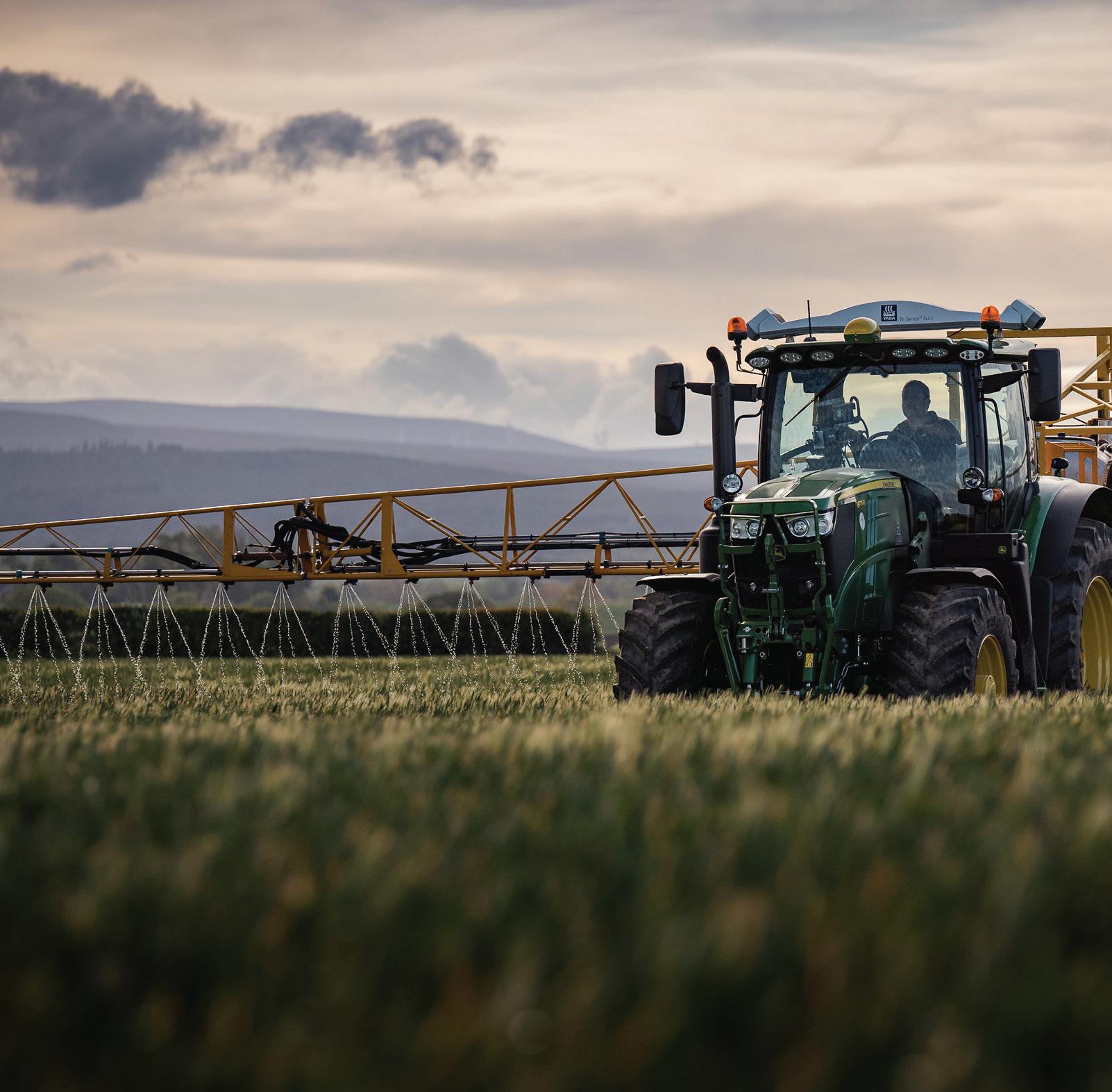
1800 684 266 Yara Australia au.contact@yara.com www www.yara.com.au
ENHANCE YOUR CROP PERFORMANCE
YaraVita foliar fertilisers are the efficient, reliable and easy way to enhance your crop performance.
According to Yara Crop Nutrition Commercial Manager, Paul Eitzen, They deliver essential micronutrients to cereal, canola and cotton crops to optimise growth or reduce the risk of crop damage, according to Yara Crop Nutrition Commercial Manager, Paul Eitzen.

“YaraVita products are an essential part of any integrated crop nutrition solution for farmers who want to increase efficiency and crop performance.,” he says.
“They enable farmers to address specific nutritional challenges or adverse growing conditions at any time from germination to harvest.”
“The YaraVita portfolio supports sustainable farming by enabling growers to achieve maximum yield potential with fewer inputs. The formulations are designed for maximum nutrient use efficiency and when used at the recommended dosage, do not have a negative impact on the environment.”
“As highly concentrated formulations, lower application rates are utilised to provide the correct amount of nutrient to the crop when compared to many other products, reducing transport, storage, handling and packaging waste.”
“YaraVita products are formulated to ensure crop safety and optimum performance. Each formulation contains all the necessary wetters, stickers and absorption aids to enhance crop safety and uptake by the plant and ultimately, the best return on your investment in crop nutrition.,” Paul says.
Independent research has confirmed that YaraVita foliar fertilisers pose
significantly less risk to crops than chelated formulations, despite delivering much higher concentrations of nutrients.1
In one study, the performance of YaraVita MANTRAC PRO, COPTRAC and ZINTRAC was compared to that of chelated manganese, copper and zinc formulations. Each pair of treatments delivered the same concentration of nutrients (500 g/L manganese, 500 g/L copper and 700 g/L zinc).
Leaf damage was assessed seven days after spraying and classified as unscorched, slightly scorched, moderately scorched or severely scorched.
In this trial, all three YaraVita formulations produced significantly lower levels of phytotoxicity than chelated products.
“YaraVita products are also compatible with a wide range of crop protection products for cost-effective, one-pass application. Data from Yara’s Tankmix confirms that YaraVita products can be mixed easily with other agrochemical products.
You can access over 30,000 tank mixes at by visiting www.tankmix.com . These mixes can be ordered around the clock, 24 hours a day all year round ovia the website or by r downloading the free Tankmix IT app.
YaraVita fertilisers are packaged in 10 litre ‘A Pack’ recyclable polyethylene bottles, including the labels and caps. All YaraVita bottles and caps are recyclable at drumMUSTER.
“Packaging design and size have an important role in the safe and easy handling of crop nutrition products,” Paul says.
“The ergonomic handle can rotate 360 degrees, while the central opening ensures smooth pouring, fast mixing and easier rinsing.”
Yara’s R&D and production facilities in Pocklington, UK have extensively tested YaraVita products to meet quality and consistency standards. The high quality and consistency of YaraVita products is certified throughout the production process. This includes certification of the quality of raw materials in manufacturing; ISO certification of quality management and GlobalG.A.P, a trademark and set of standards for good agricultural practices.
“These standards cover everything from where and how we source raw materials, right through to formulation, manufacture, trials, labelling and logistics,” Paul says.
“Many of the raw ingredients are sourced from the cosmetic, food or pharmaceutical sectors.”
“Yara also maintains a comprehensive testing and sampling system to ensure each batch meets the stated specification and can be traced back to the raw materials used in that batch.”
Farmers can be assured that by using YaraVita, they can depend on the product’s quality and consistency to achieve high crop yield.
Other crop nutrition products marketed by Yara Australia are YaraMila NPK compound fertilisers, YaraRega soluble NPK compound fertilisers, YaraTera crystalline fertilisers and YaraLiva calcium nitrate fertilisers.
59 Crop Health
1. Safety assessment of foliar applied chelates compared to formulated YaraVita products, YaraVita Development and Training Centre, Pocklington, 2018.
ORGANIBOR- A SOLUTION TO BORON APPLICATION
The role of boron in crop nutrition is far more diverse than many of us realise. We often think of boron as a requirement for pollen viability (mixed fruit size, poor fruit set) but it is also essential for cell structure and strength, disease resistance, healthy root production and calcium mobility within plants.
However, there can be a fine margin between deficiency and toxicity –and easy leaching out of the soil profile – boron works with calcium to build a strong cell structure in plants to prevent symptoms like internal flecking in potatoes or hollow heart in brassicas. It also has a prominent role in pollination and is needed for proper root elongation.
Boron management in most crops can be challenging. Fully soluble forms of boron that can be blended into fertiliser mixes must be applied at modest doses to manage the risk of toxicity.
Boron is highly prone to leaching, particularly in sandy soils, and will not remain present in the soil with regular rainfall or irrigation. Foliar sprays are an option but with boron being needed constantly through the plant’s growth cycle frequent applications are required.
One solution is to use a slow-release form of boron.
Omnia Specialities is the Australian distributor for OrganiBOR, a boron product containing calcium and magnesium borate (Hydroboracite) that
are citrate soluble rather than water soluble. It is also a certified input for organic producers.
OrganiBOR granules are essentially insoluble in water. When in contact with the soil OrganiBOR breaks down slowly via microbial activity and natural weathering in a moist environment. Under these conditions soil Boron levels are seen to increase within a matter of weeks and, as they continue to break down, the granules provide a constant supply of available boron to crops until the granules ultimately disappear. During this breakdown process OrganiBOR will create a Boronrich soil environment for a period of 1 to 3 years depending upon rates and environmental factors.
Table 1 below shows a recent glasshouse trial where 2 soluble boron forms were applied to the soil in comparison to OrganiBOR in capsicums. All 3 products were applied at rates adjusted to apply the equivalent of 2.5kg of elemental boron per hectare. The soluble boron products caused visual toxicity symptoms and significantly decrea sed plant growth. However, OrganiBOR showed no toxicity symptoms.
More importantly, OrganiBOR increased the weight of the capsicum fruit over control, whereas the toxicity of soluble boron reduced fruit growth.
Calcium content was also statistically increased by the application, which indicates the correct balance of boron supply leading to healthy root growth and calcium uptake.

Table 2 below displays soil Boron increases in tree crops from one application of OrganiBOR over several years.
The bottom line. Growers have consistently seen good boron availability for at least two seasons per application of OrganiBOR.

This makes it a ‘set and forget’ product where the soil can be treated every two years, using soil tests to monitor levels, regardless of how many crop cycles are carried out. The combination of ease of use, crop safety and consistent boron supply to the crop make this the premier boron solution for vegetable crops.
Find out more. Please visit omnia.com. au/agronomists to contact your local Omnia Specialist Agronomist.
Table 1: Capsicum plant weights by month.
60 elders.com.au Crop Health
Table 2: Soil boron level increases by year after application into almonds. Increases in soil boron levels could still be seen four years after application of OrganiBOR into almonds at Robinvale, Victoria.
Omnia Specialities Australia



Experts in Soil Health and Crop Nutrition


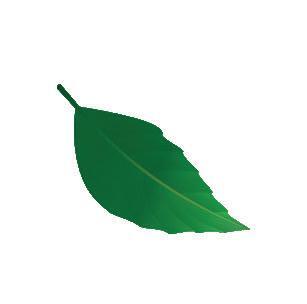


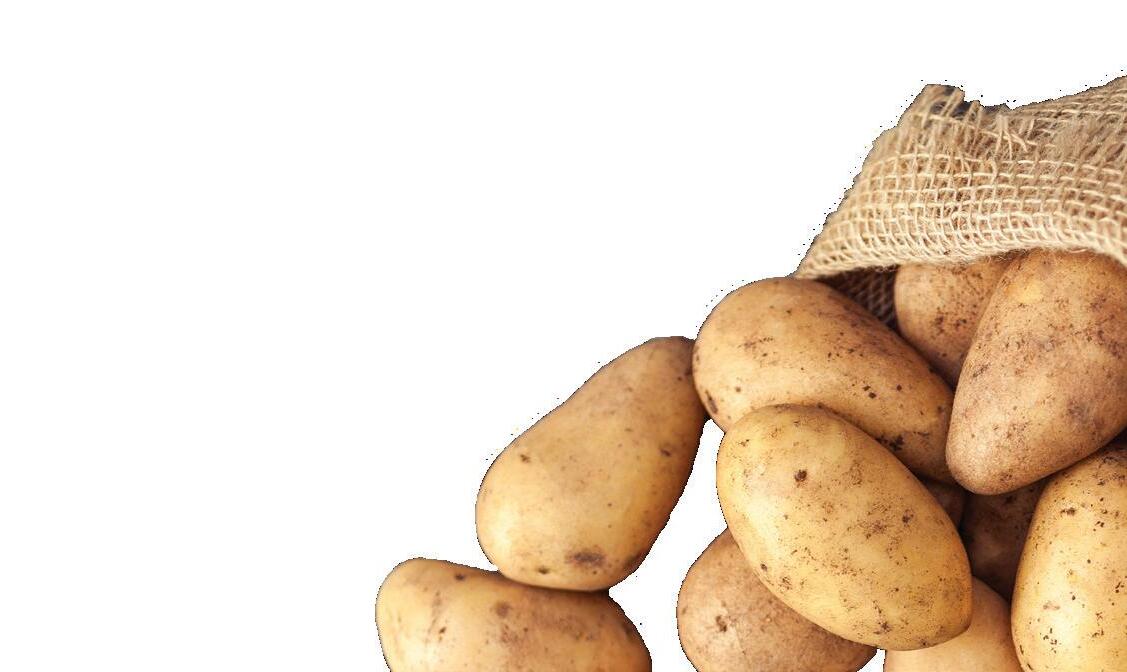


One application available for up to two seasons safely
importance of Boron: • Structural strengthening call walls • Improves pollen viability • Enhances calcium mobility • OrganiBOR is certified for organics Talk to your Elders Agronomist or an Omnia Specialist Agronomist
The
The Omnia Range includes: • World Class Humates • Biologically Enhanced Foliars • Microbes • Seaweeds • Trace Elements • Unique Crop Nutrition Solutions (03) 5133 9118
YOUR ONE STOP SHOP FOR LONGER LASTING
GATE FITTINGS
TRY CYCLONE’S GATE FITTING PICKER TODAY! CLICK HERE!

GET THE RIGHT GATE FITTING FOR YOUR FENCE
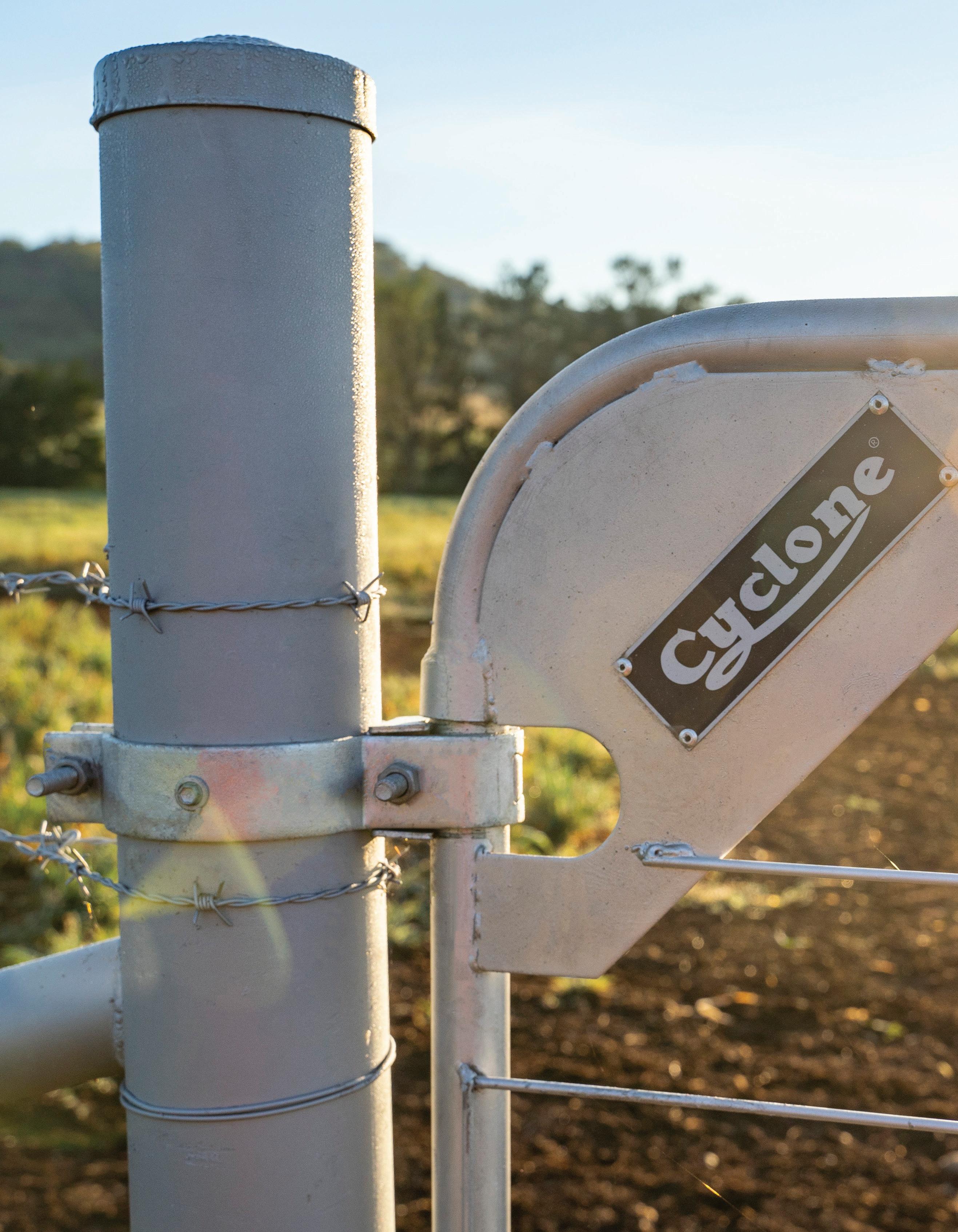
CYCLONE’S TRIED AND TRUE GATE FITTINGS!
Cyclone provides a large range of gate fittings to suit all gates and strainer types. From steel, timber and concrete, Cyclone has all your gate fitting needs covered. All Cyclone gate fittings come hot dipped galvanised, which provides customers with added corrosion protection that is far superior to other gate fittings on the market.
Cyclone’s hot dipped galvanised gate fittings were put to the test in our local laboratory with some interesting results. Three different gate fittings were tested: a Cyclone hot dipped galvanised gate fitting (cyclone gate fitting), and two different zinc electroplated (zinc electroplated 1 & zinc electroplated 2) gate fittings. All gate fittings were installed in a timber post and subjected to an accelerated salt spray environment for 3 months (1,500 hrs). These were the results:

Within the first 500 hrs the zinc electroplated 1 had jumped up to 72% corrosion while the zinc electroplated 2 was at 12%. The Cyclone gate fitting had only reached 7% corrosion.
At 1,000 hrs, the ineffectiveness of the zinc electroplated gate fitting was starting to
show. The zinc electroplated 1 had reached 86%, zinc electroplated 2 had skyrocketed up to 72% corrosion, while the Cyclone gate fitting had risen slightly to 26%.
At the end of the 1,500 hrs, zinc electroplated 1 was 95% corroded and zinc electroplated 2 was 100% corroded. In contrast, the Cyclone gate fitting had only reached 30% corrosion.
The test conditions, gate samples and salt solution were conducted to meet Australian standards and red rust was used as the determinant of coating degradation and failure. This test really demonstrated the anti-corrosive power of hot dipped galvanised gate fittings.
Corrosion to gate fittings can create all sorts of issues. The corrosion can migrate to your gate and could also get into your wire, damaging the entire integrity of the fence line. Peter Reeves, the NSW State sales manager, has seen too often what can happen when farmers get it wrong. “A fence line is only as strong as it’s weakest link. When you use the wrong gate fittings you are creating that weakest link which will soon infect the entire integrity of the fence line.”

Cyclone’s gate fittings may not look the shiniest and may not have the gleam and colour, but their rugged look is what allows them to outperform other gate fittings on the market. Peter said, “I know our gate fittings aren’t the best to look at, but this allows them to last longer! I would recommend you give them a try, I think you will be surprised.”
Need help selecting the right gate fitting? Head to the Cyclone website and try the ‘gate fitting picker tool’! It’s a great way to logically select the right gate fitting –Firstly, pick the type of Cyclone gate you have purchased, then select your strainer post material (timber, steel or concrete); then select your fitting! Then you can print the flyer or click to download it straight to your phone or computer. Use this tool at www.cycloneproducts.com.au/gatefitting-picker or on the Cyclone gate fitting page.
To find out more about Cyclone’s gate fitting range, the gate fitting picker or the corrosion testing, visit www.cycloneproducts.com.au or call 1800 199 450.
 Figure
Figure
1: Before salt test
63 Fencing
Figure 2: After 1500 hour salt test
FOR THE FARMERS AND THEIR COMMUNITIES
for Australian Agriculture

elders.com.au





















































































































































































































 Figure
Figure


